Masaka, Uganda. 30th of May 2025..
We enjoyed the “adventure like no other” which is the Uganda Marathon, running up and down hills through red earth paths with lush vegetation, and across the vibrant streets of Masaka while, around us, students sang and people were going to the local market.
TLDR; “too long, didn’t read”
- I want to check out the Uganda Marathon! Take me to RACE.
- I just want to run in the wild! Take me to RUN IN BWINDI.
- I have 1 minute. Take me to USEFUL INFORMATION.
- Running is my excuse for travelling. Take me to TRIP.
- Running is my excuse for eating. Take me to CARBOLOADING.
- I want to know what to read in the plane. Take me to ONE BOOK.
🌍 The Trip 📷: What to do in Uganda before or after the Uganda Marathon
🎥 A land where an epic film was located 🎥
Before we travelled to Uganda I saw “The African Queen“, a movie I had seen in the past and really loved. Watching it added a special touch to the experience, as parts of the classic film were shot on location there.
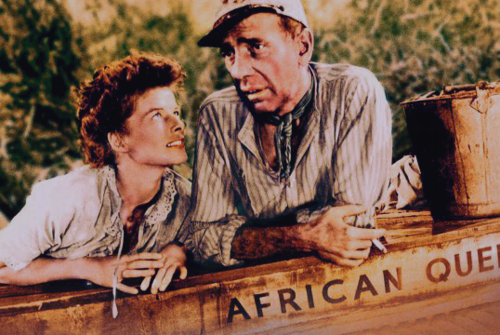
The original steam-powered boat from the movie still exists and apparently can be seen (and even ridden) in Jinja, on the North shore of the Lake Victoria. We didn’t venture that far, though. Maybe next time!
The lush landscapes, winding rivers, and untamed beauty captured in the film reflect Uganda’s real-life scenery, and later it made exciting to recognize familiar sights. Seeing The African Queen before our trip offered a nostalgic connection to Uganda’s cinematic and historical charm – I recommend it!
In this article you can find the list of locations for the movie, including the amazing Murchinson Falls.
🇺🇬 The visa! 🛂
You need to apply for a visa in advance! Luckily an e-visa can be obtained online and it is a straighforward process: it took only 2 days for us.
We got ours and we realised that, however, we need to bring in a printed version of the visa with us! Be cautious with that. Indeed, when we passed customs they did look at the printed version.
❔Why run the Uganda Marathon?
I wanted to run the Uganda Marathon since 2023 when I found its website when researching about marathons in Africa.
It was announced as “An adventure like no other” and reading about it, seeing the pictures and understanding the project(s) behind it, the idea of running it appealed to me.
The proposition is that you spend “An adventurous week into the Pearl of Africa, with activities through breathtaking landscapes combined with incredible gorilla trekking and safari extensions, to make a difference in Education, Health and Community development”
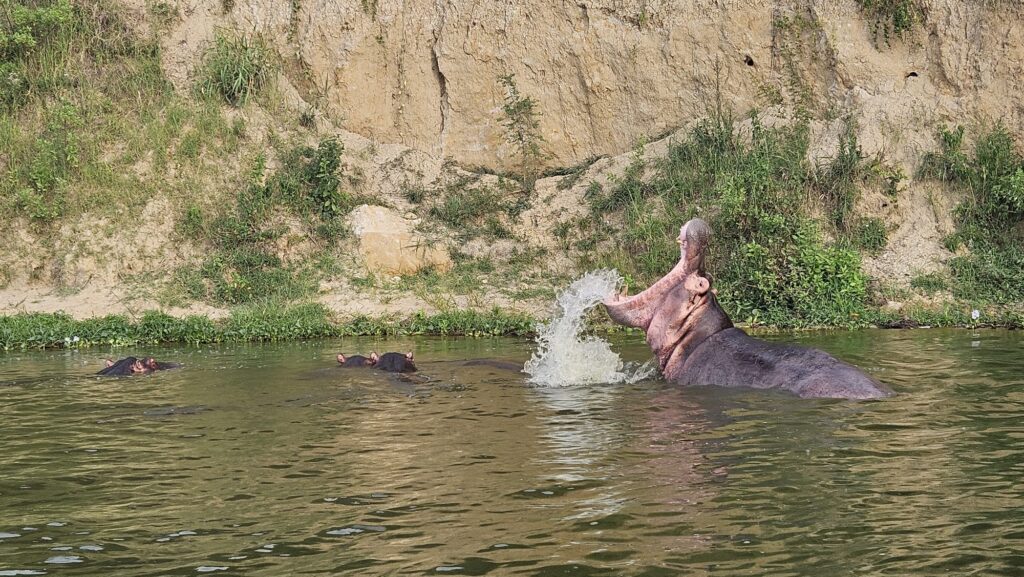
Unfortunately we didn’t have a whole week as we had a very busy agenda in Africa, so we just signed up for the marathon and decided to contribute in a different way.
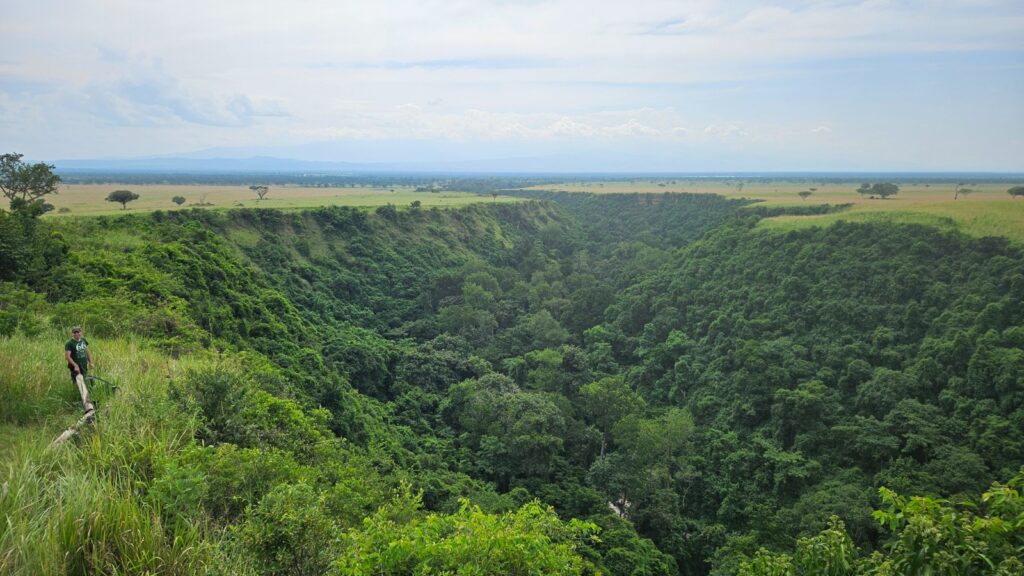
❔Why visit Uganda (and not only to run the Uganda Marathon)?
Visiting Uganda gives you the chance to view the most amazing animals… in the wild!!
You can see lions, elephants or leopards, part of the famous ‘Big Five’….
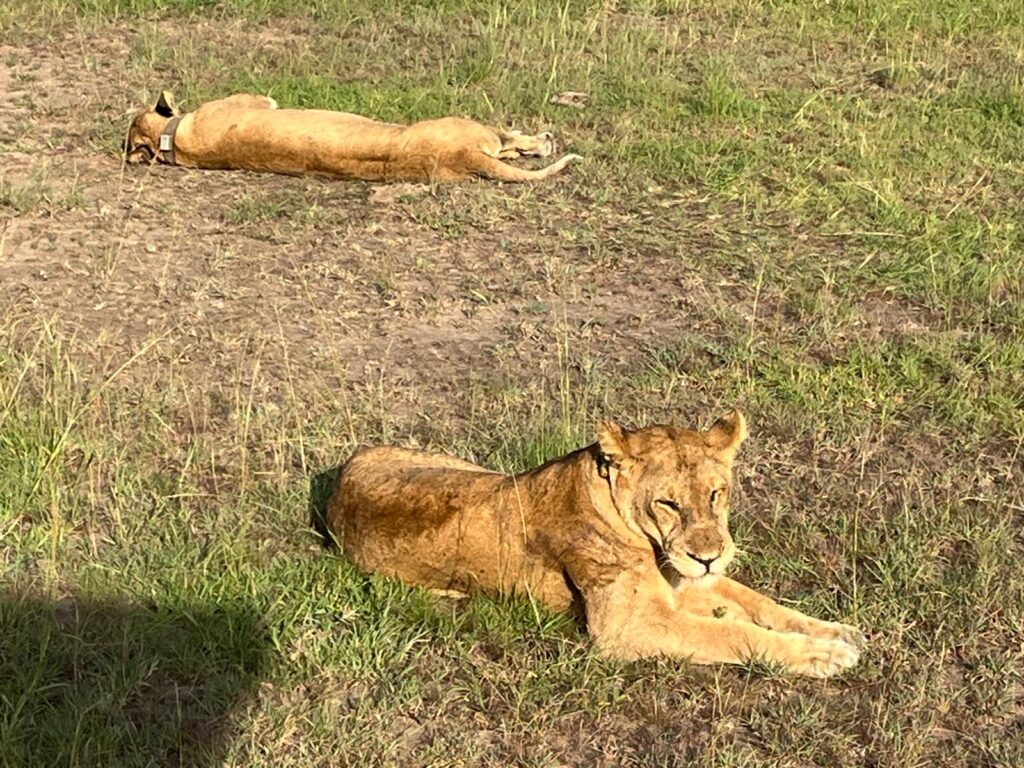
But in Uganda you can also see great apes. We trekked and walked amongst chimpanzees and mountain gorillas. In the wild.
It was unforgettable, as I will describe later.
Plus, Uganda is quite well prepared for tourism (unlike other African countries) but it is not as crowded as Kenya or Tanzania.
In summary, highly recommend visiting. Both if you love animals or if you want to run in a truly fantastic place.
🌍 Our Trip / Guide: Highlights of Uganda 📷
So, on a sunny morning of May we arrived in Entebbe from Djibouti, stopping over at Addis Ababa in Ethiopia. Addis Ababa seems to be the new hub of flights across Africa, with Ethiopian Airlines labelling itself as “the new Spirit of Africa”.
The flight was 2 hours long and we crossed customs without problems as we had applied for a visa in advance.
Entebbe: the gateway to “the Pearl of Africa”
Uganda’s slogan is “the Pearl of Africa” and we started seeing ads with the slogan already in the airport.
The slogan refers to its exceptional natural beauty, diverse landscapes, rich wildlife, and hospitable climate. It was popularized by Winston Churchill in his 1908 book “My African Journey”, where he wrote:
“For magnificence, for variety of form and colour, for profusion of brilliant life—bird, insect, reptile, beast—for vast scale… Uganda is truly ‘the Pearl of Africa.'”
Not surprisingly, I ended up buying the book to understand more about the colonial Africa he travelled around in 1908 and, more concretely, the Ugandan Railway.
In the airport we also saw a statue of a massive gorilla in the airport and we couldn’t resist taking a picture with it, with Roger making the joke: “I hope they are not so big in reality!”
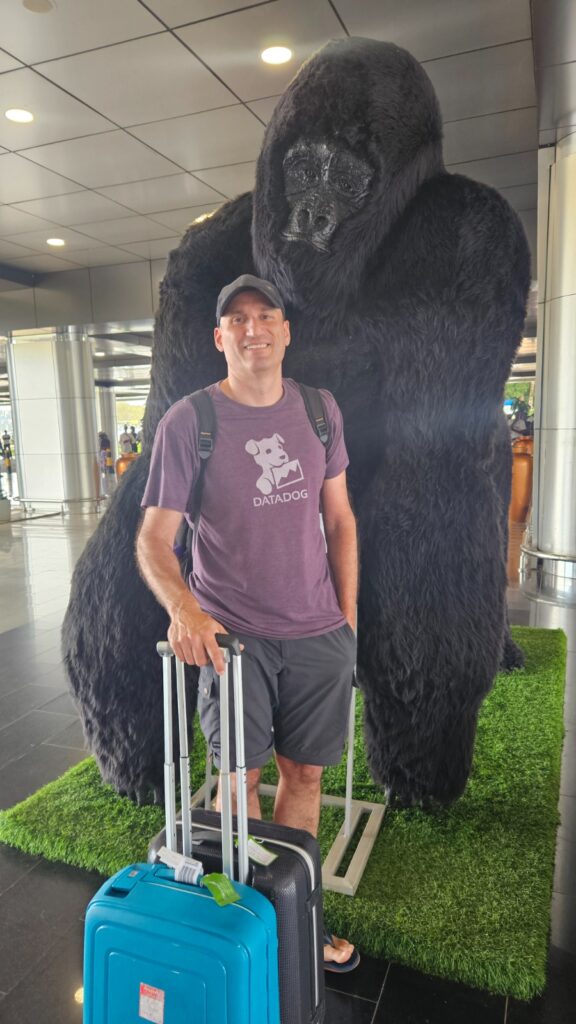
First impressions
We had booked a tour with Pamoja Tours and Travel and Leticia, who was to be our guide, was waiting for us at the airport.
On our first drive, I saw the familiar details of an African city.
Buildings with barbed wire, stalls with publicity painted, the people selling fruits in the streets, the motorbikes.. but with one difference! Here I saw many motorbikes with an umbrella installed to give shade to the driver, which I thought was a brilliant idea!
🍌Also, a lot of people carrying bananas, in all kind of transport means!
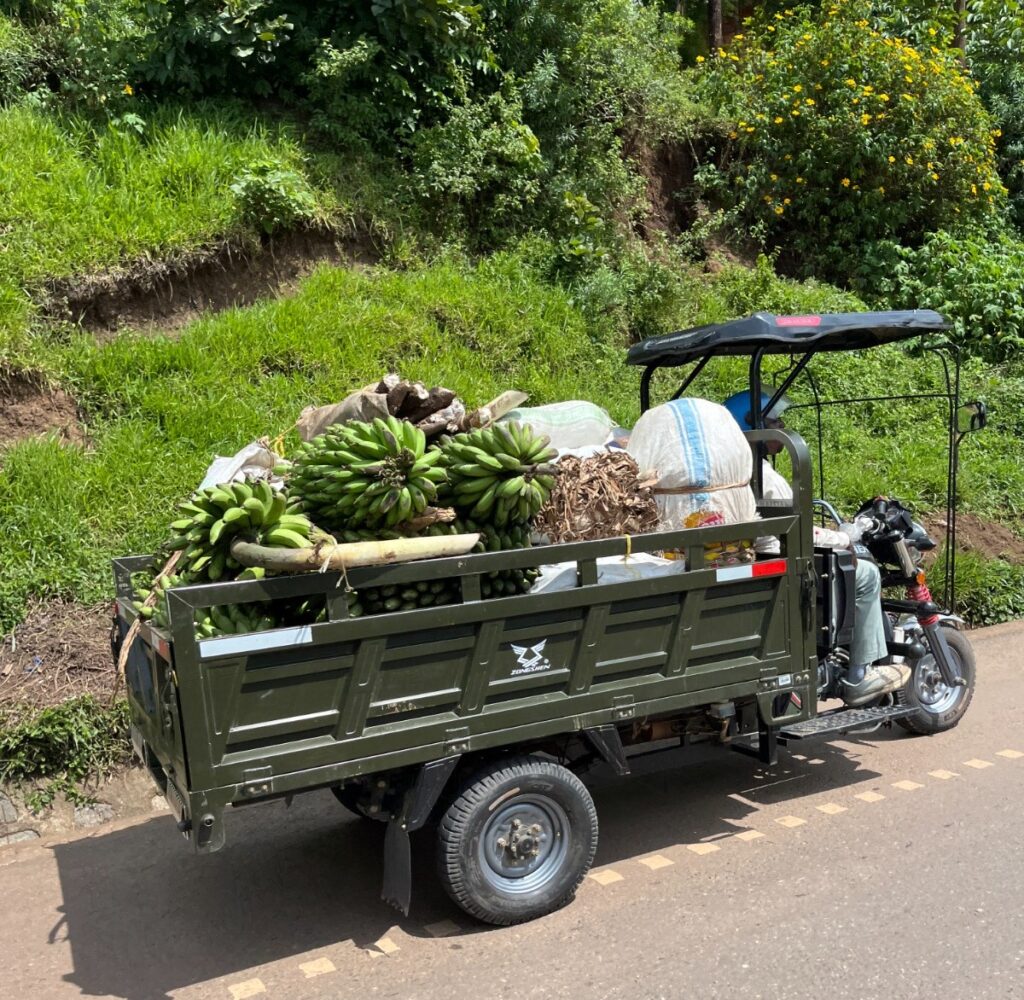
I loved to see the first landscapes that I had seen in photographs: red earth and exuberant vegetation, with a lot of vibrant greens and tropical trees.
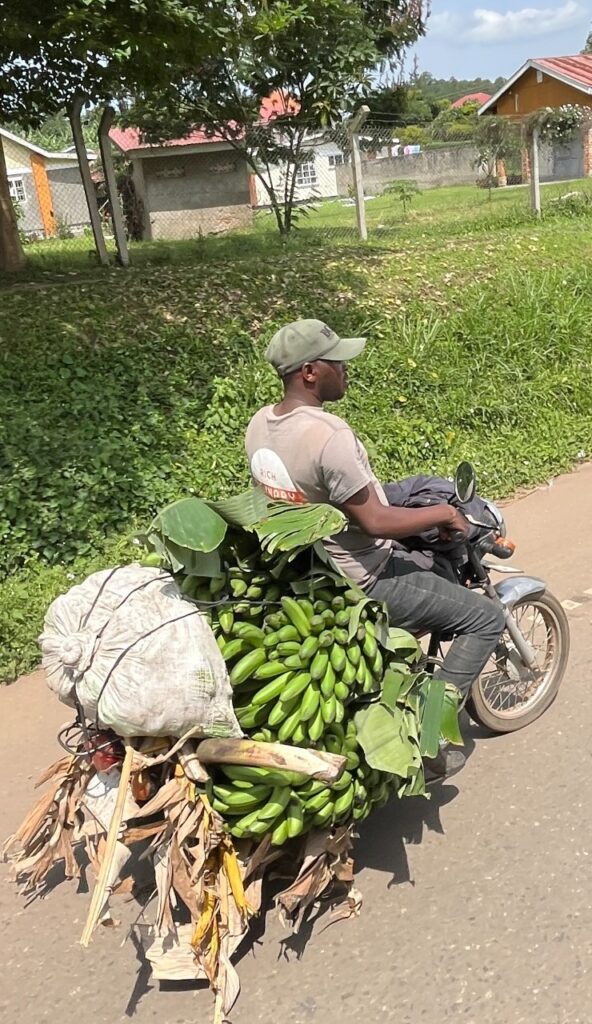
Starting to learn more about Uganda 🇺🇬
Anyway, our guide Leticia started explaining interesting things about Uganda and its apes. I asked many questions and she happily answered all of them.
For instance, did you know that chimpanzees elect their leaders? They vote!
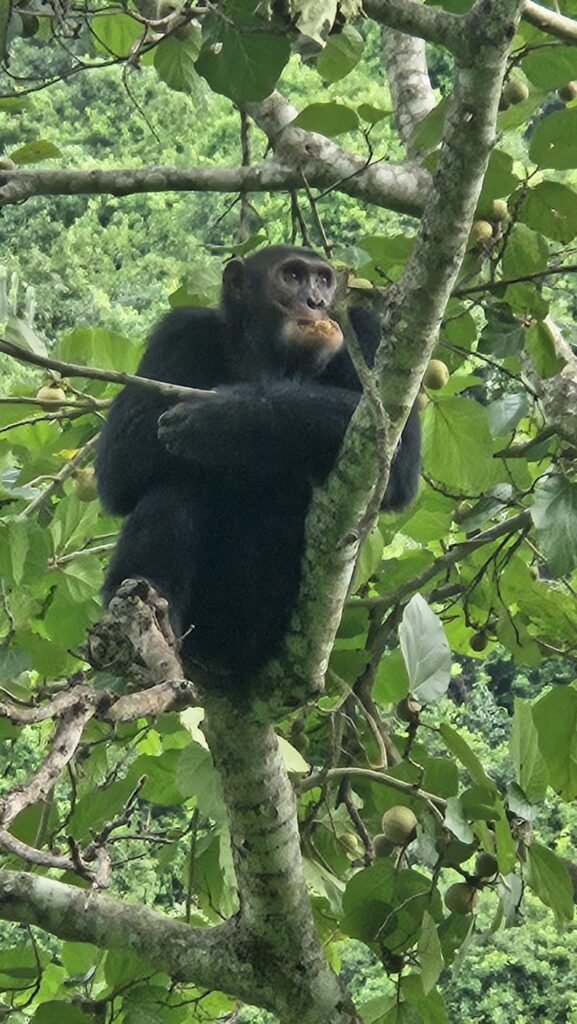
Of course we made a couple of easy jokes about this 😂
I later asked chatgpt about it, and chatgpt confirmed it:
“Chimpanzees don’t vote, but they strategically “choose” leaders through a mix of dominance, alliance-building, and social favor—like a primal form of politics. Leadership is earned, maintained, and lost through a dynamic and often dramatic process that reflects a surprising degree of social sophistication”.
A travellers café to start our adventure
We spent the first night in a guest house / travellers café in Entebbe: ViaVia Guest house.
Despite being in a ‘city’, the guest house seemed to me to be in the middle of the jungle because of the vegetation.
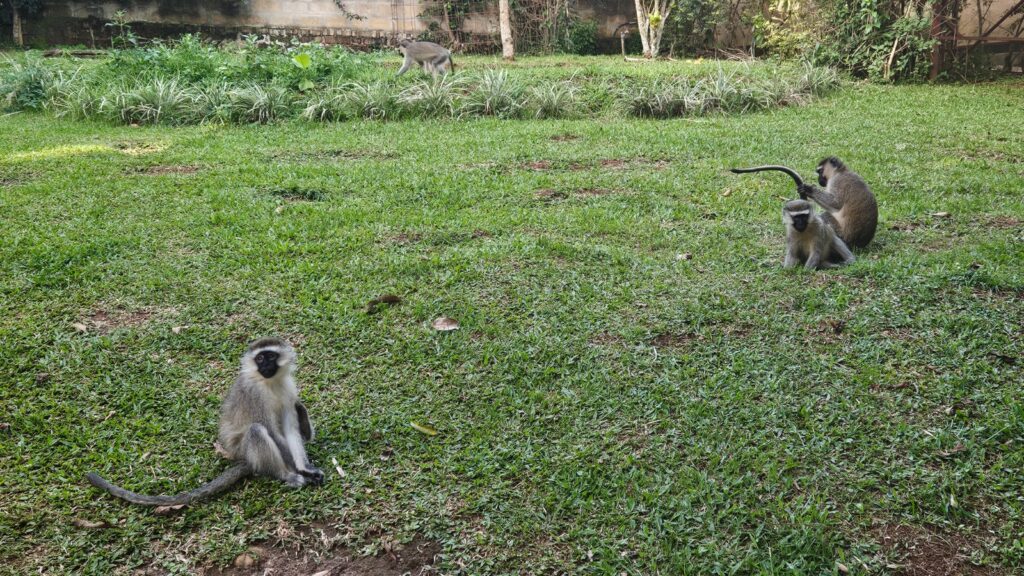
There were monkeys running around the premises! And during the day but especially at night, the sound of a multitude of birds was very noticeable.
The place offered good wifi, yoga and boxing classes and had a swimming pool in front of a water puddle looking very tropical:
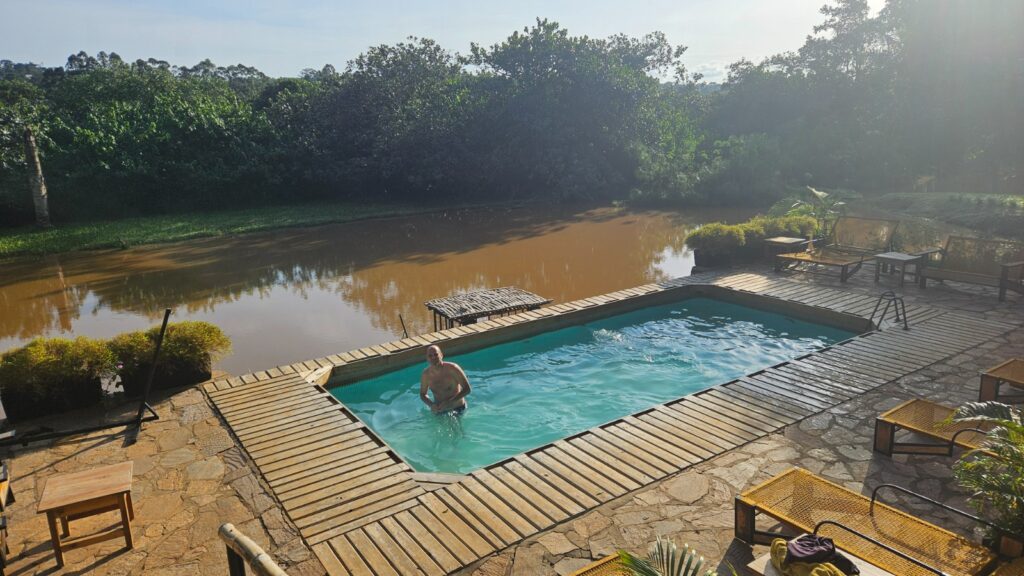
🐵 Watching out for our Breakfast 🐒
We had breakfast in the amazing café in the garden. It was chilly, the lush vegetation was covered with morning dew and we could hear the birds singing and the monkeys running around.
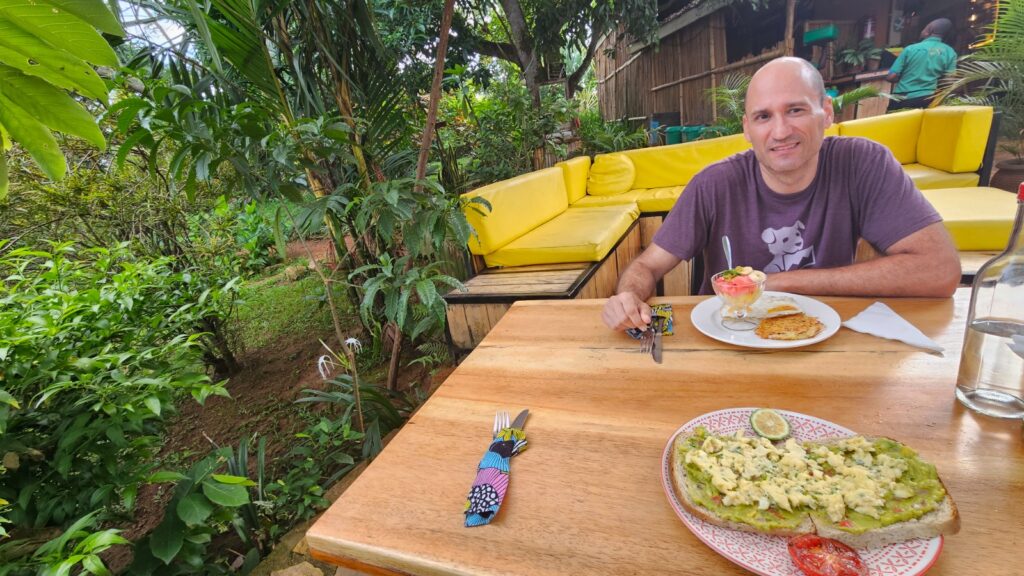
So cool, such a relaxing vibe. A sign read “Live. Laugh. Live”. I couldn’t agree more. Jazz music was playing quietly…. We were in Africa and I kept thinking of Winston Churchill’s words that so well described the place… 120 years later!
But “a threat” was surrounding us 😅…
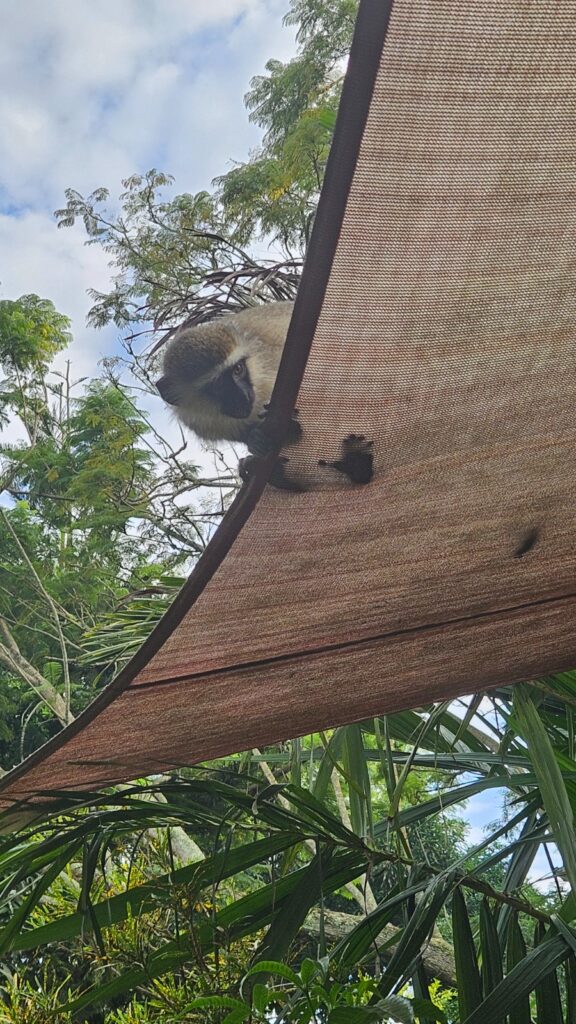
We asked the waiter whether the monkeys were going to eat our breakfast and he smiled and said “most probably!”. But he also said that when they see a man they do not steal food as much🫡. Apparently I was a target 🤔! No big news here!
So Roger prepared his slippers to frighten them! 🤣🤣
By the way, we overheard a curious and very random conversation In the table next to us: a group of British people talked about a family who lived here and did 200 safaris (?!?!) but never seen a single leopard and that “the husband was a bit of a racist” 😅. Not sure how they went from one topic to another 🧐
Entebbe Botanical Gardens and Lake Victoria
Firstly, we visited the Entebbe Botanical Gardens and Lake Victoria. Although it was actually not easy to drive in, because the entry path looked like this:
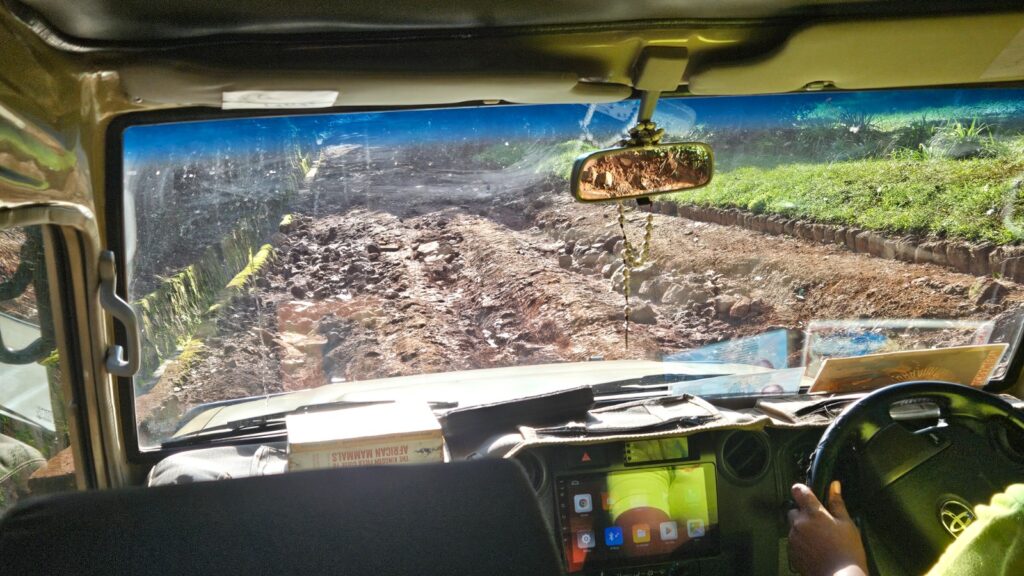
The Botanical Gardens, established in 1898, are a serene haven showcasing a variety of indigenous and exotic plant species.
And when I say exotic, I mean exotic. Look at the size of this spider!
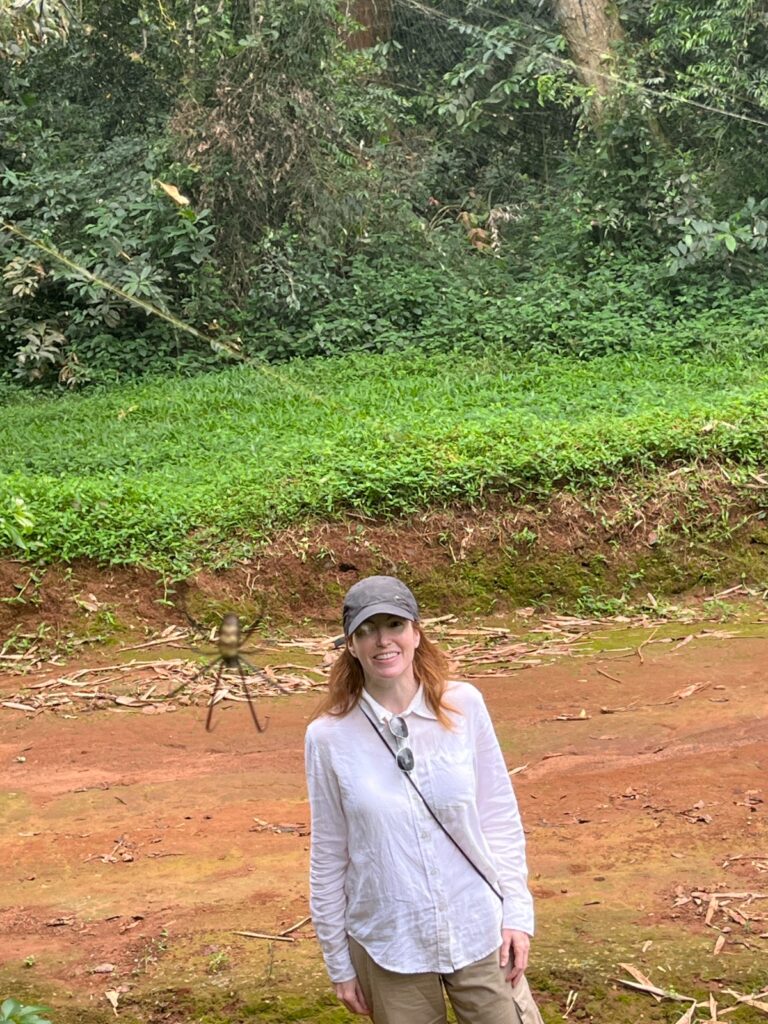
It is located on the shores of Lake Victoria and offers scenic lake views. Lake Victoria, Africa’s largest lake and the world’s second-largest freshwater lake by surface area, has a deep historical and geographical significance.
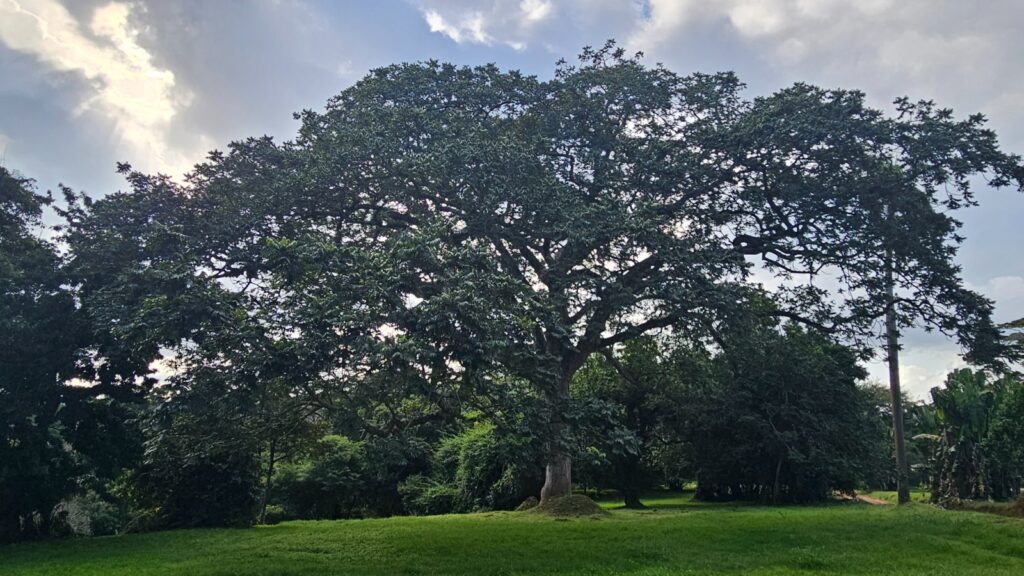
Named in 1858 by British explorer John Hanning Speke in honor of Queen Victoria, the lake was a major landmark in European exploration of Africa, particularly during the search for the source of the Nile River.
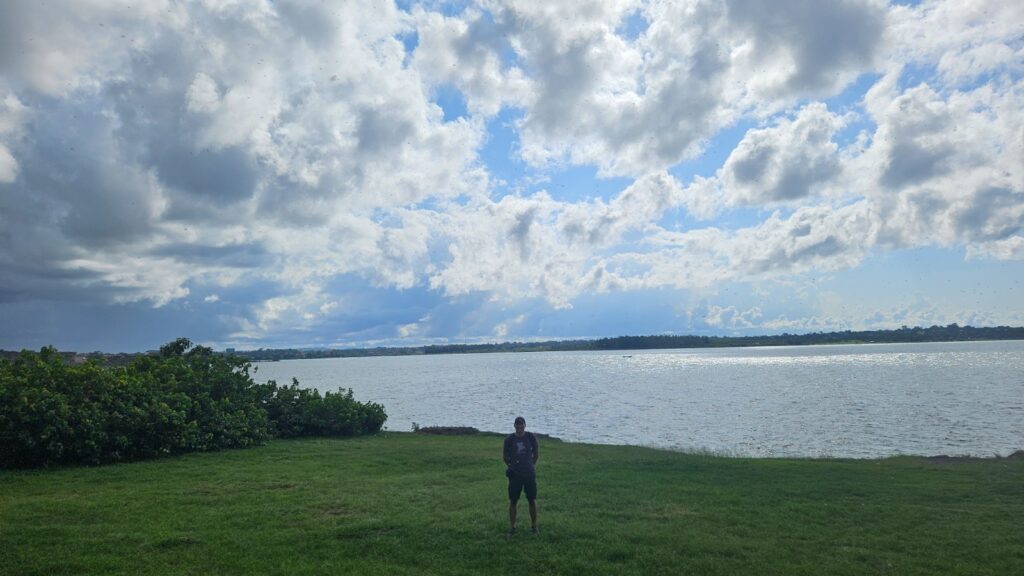
We didn’t know yet that later during the same trip, when we reached Burundi… we would actually see the primary source!!!
🚙 The journey from Entebbe / Kampala to Masaka 🚙
It took us around 3 hours to reach Masaka, with a stop for lunch… “at the Equator”!
Literally – it was meters away from the Equator, marked with a funny sculpture:
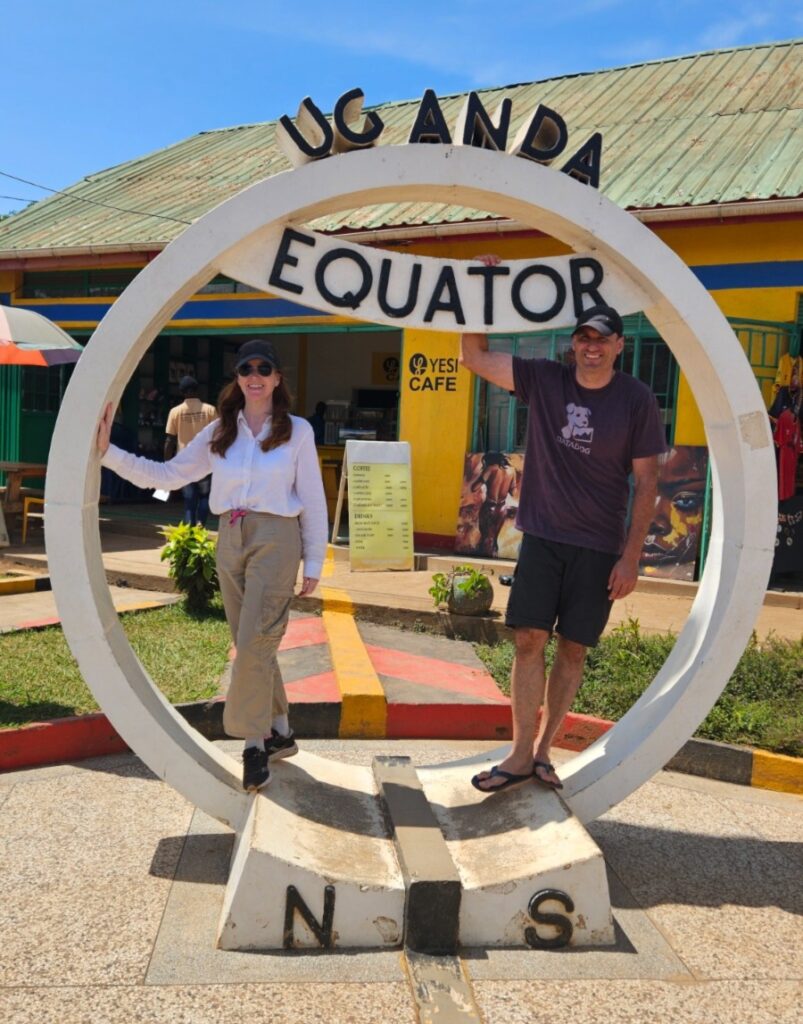
I enjoyed our drive for multiple reasons. For instance, I could see the hills up and down: red earth in a steep slope surrounded by lush greens… evocative and exotic; the same image that attracted me to come when I saw it on the marathon website.
Everywhere, women carrying all kind of things on their heads: a practice deeply rooted in cultural tradition and practicality. From jerrycans of water and bundles of firewood to baskets of produce or market goods, women often balance heavy loads with remarkable poise and strength. This method of transport allows them to carry more than they could by hand and keeps their arms free, especially when walking long distances along footpaths and village roads.
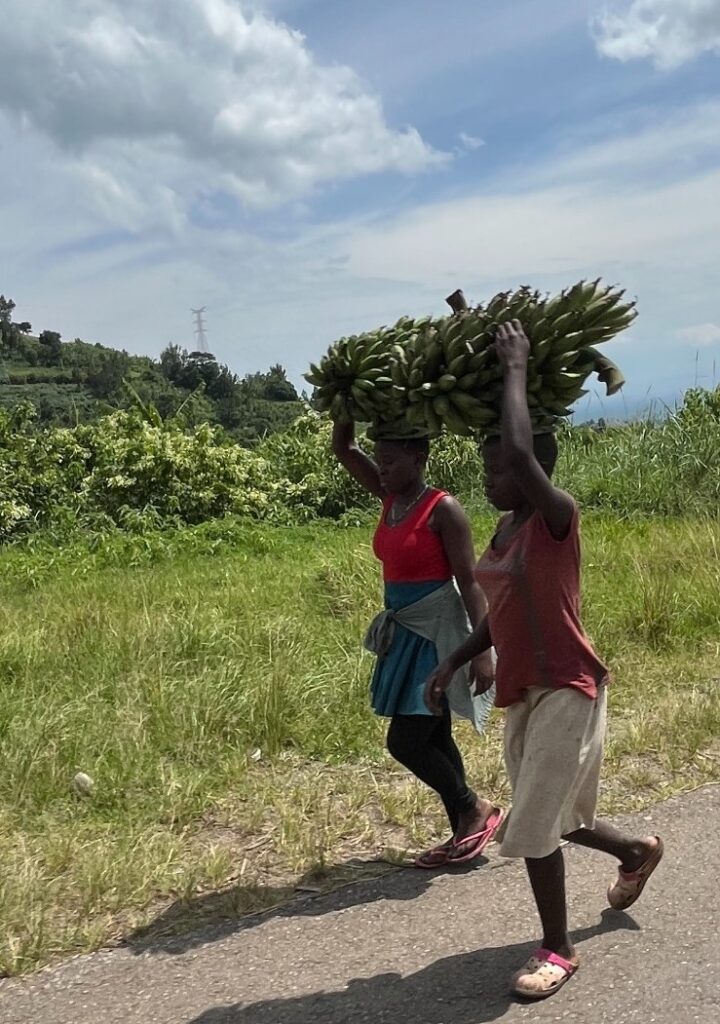
While efficient, this physical burden is emblematic of the disproportionate labor responsibilities women bear in Ugandan society, often from a young age and with little external support.
We also saw tea fields, so green it looked like somebody had applied an instagram filter!
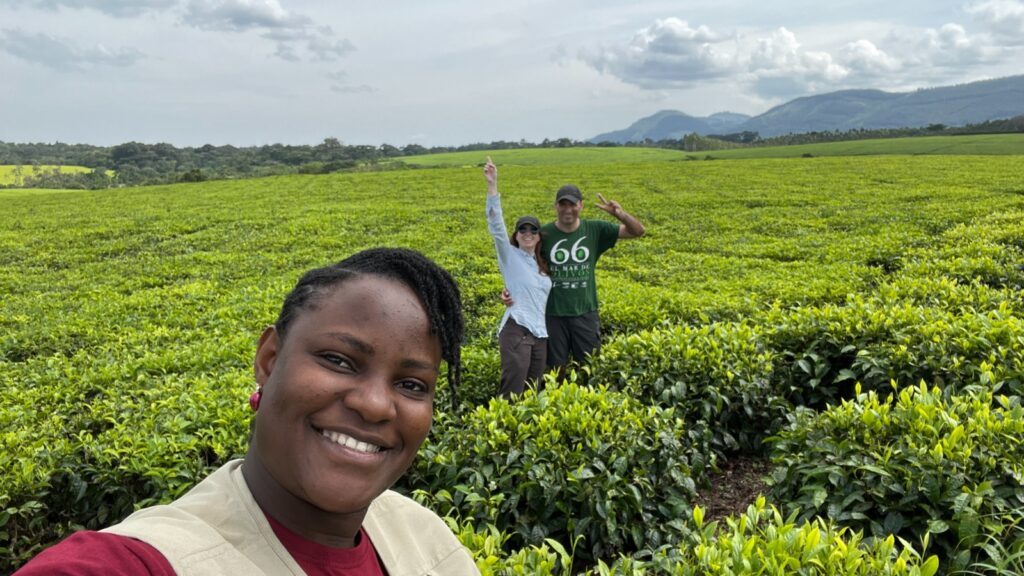
In recent years, the tea industry has seen modest growth, with both smallholder farmers and large estates contributing to domestic production and export. However, challenges remain: fluctuating global prices, climate change, and limited access to modern agricultural tools hinder consistent progress. Nonetheless, initiatives promoting sustainable farming and fair trade practices are gradually taking root, offering hope for improved livelihoods among tea workers and a more stable future for Uganda’s tea sector.
But, also, because elephants would appear all of a sudden… in the middle of the road!
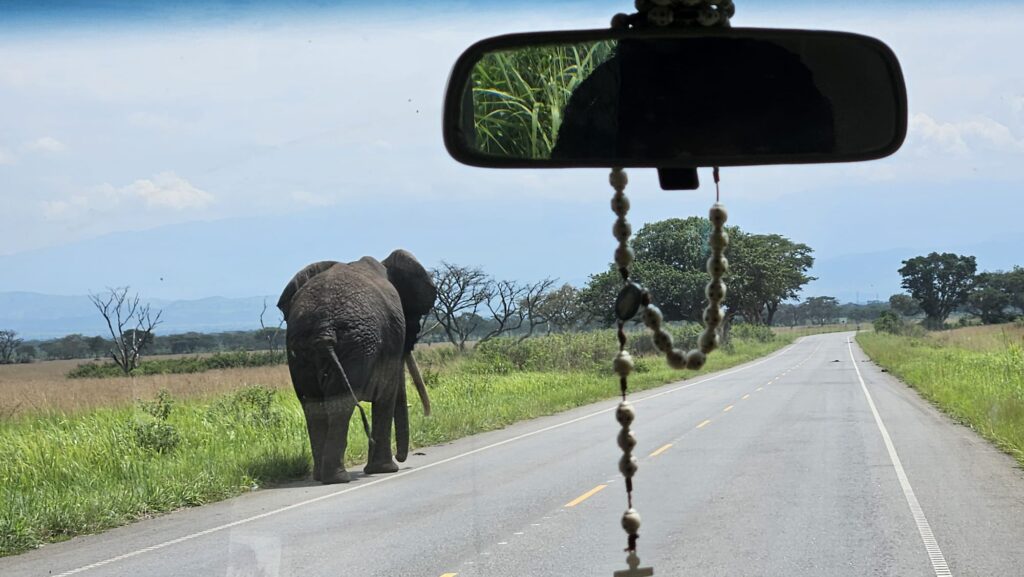
Finally, an unexpected sight: we got the opportunity to see hundreds of pilgrims walking for The Namugongo Pilgrimage!
🛐 The Namugongo Pilgrimage
Every year on June 3rd, thousands (often millions) of pilgrims from Uganda and across Africa gather to commemorate Martyrs’ Day.
Pilgrims walk hundreds of kilometers on foot from different parts of Uganda, Kenya, Tanzania, Rwanda, South Sudan, and the DRC:
It’s a deeply spiritual journey involving prayer, fasting, and reflection.
The pilgrimage often takes days or weeks depending on where the pilgrim starts.
They head to Namugongo, one of the most significant religious sites in Uganda and a major center of Christian pilgrimage in Africa.
It is best known as the place where many of the Ugandan Martyrs were brutally executed for their faith in the late 19th century.
A few days later, on June 3rd, we actually saw the ceremony broadcasted on TV while we were having coffee in a restaurant:
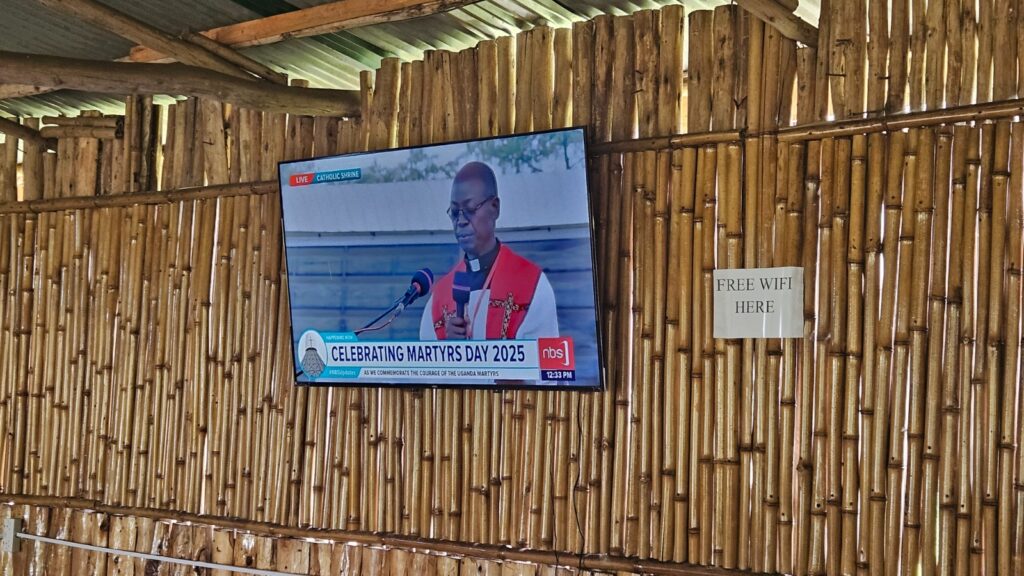
✝️ Who Were the Uganda Martyrs?
They were a group of 23 Anglican and 22 Catholic converts to Christianity, executed between 1885 and 1887 on the orders of Kabaka (King) Mwanga II of Buganda 😧
They were killed for refusing to renounce their Christian faith and for resisting the king’s sexual advances, especially in the case of the younger pages. Many were burned alive at Namugongo, while others were speared or mutilated in different areas 😭
The Kabaka Birthday Run 🏃♂️
Also, when having lunch, our guide Leticia explained to us about another run in Uganda which I did not know about.
The Kabaka Birthday Run!
She showed us a video, here, and I could see a sea of red. Thousands running, always for a cause. In 2025, as Leticia explained, it was pouring down with rain but it didn’t matter.
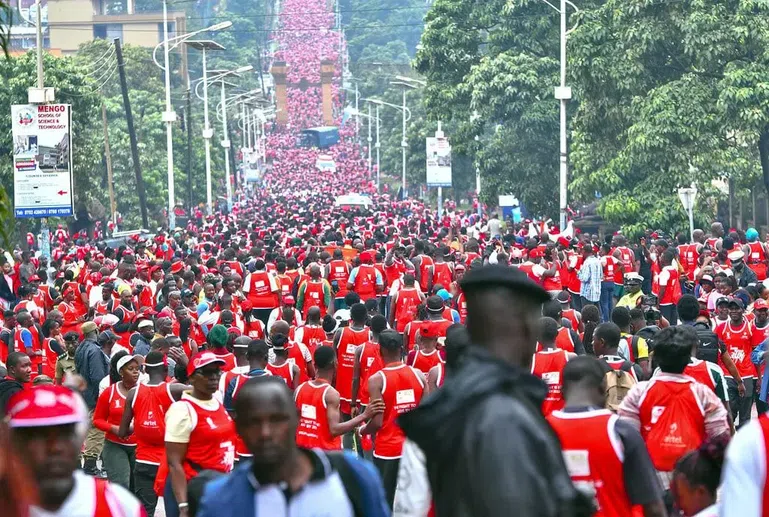
The Kabaka Birthday Run is a prominent annual event in Uganda, organized by the Buganda Kingdom to honor the birthday of Kabaka Ronald Muwenda Mutebi II, the reigning monarch of Buganda. Beyond celebrating the Kabaka’s life, the run serves as a platform to promote public health awareness, particularly focusing on the fight against HIV/AIDS.
Our Chimpanzee Trek 🐵
During our stay in Queen Elizabeth Park, named after Queen Elizabeth the second, who visited the park in 1954, we did a chimpanzee trek in the amazing Kyanbura gorge.
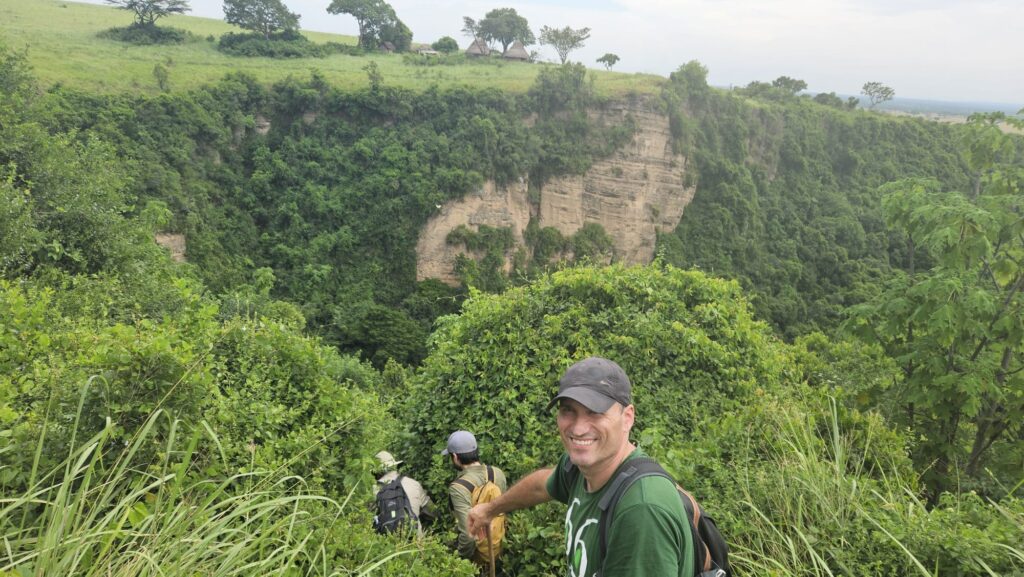
And it was terribly exciting!
First, the scenery is amazing. Not easy, though. We had to go down the gorge, and it was very steep.
We were in a small group of only 5 tourists – like with the gorillas, the groups are small.
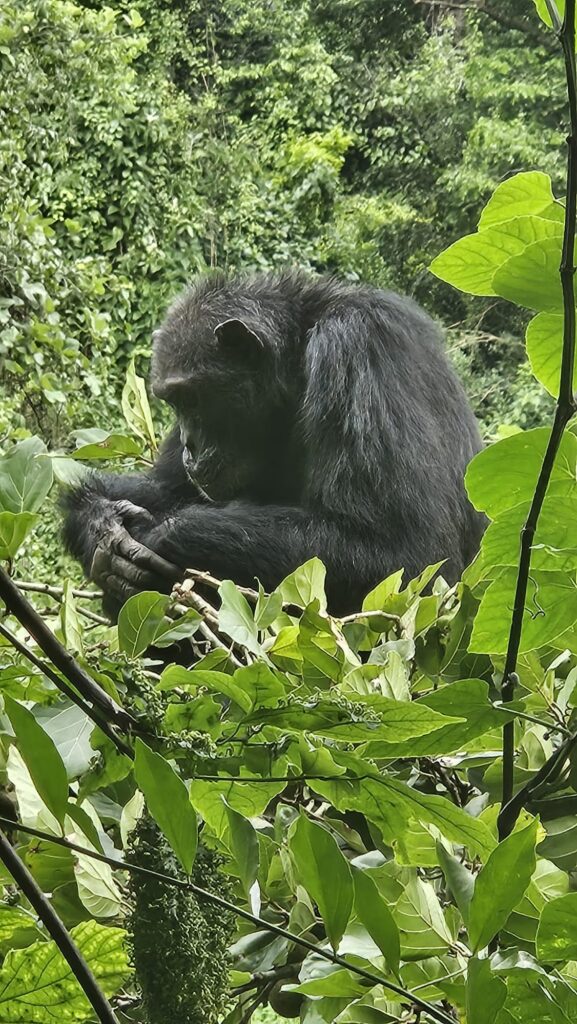
Nathan, our ranger, armed with a rifle, offered us walking sticks. I said I was not going to need them… and I almost had to ‘eat my words’ since the climb was much harder than I imagined.
It was a difficult trek, both going down and then up, amongst very thick vegetation and the sound of insects, which gave you a sense of how wild the place was, but it was worth it.
We say a group of 7 chimpanzees very close, at eye level!
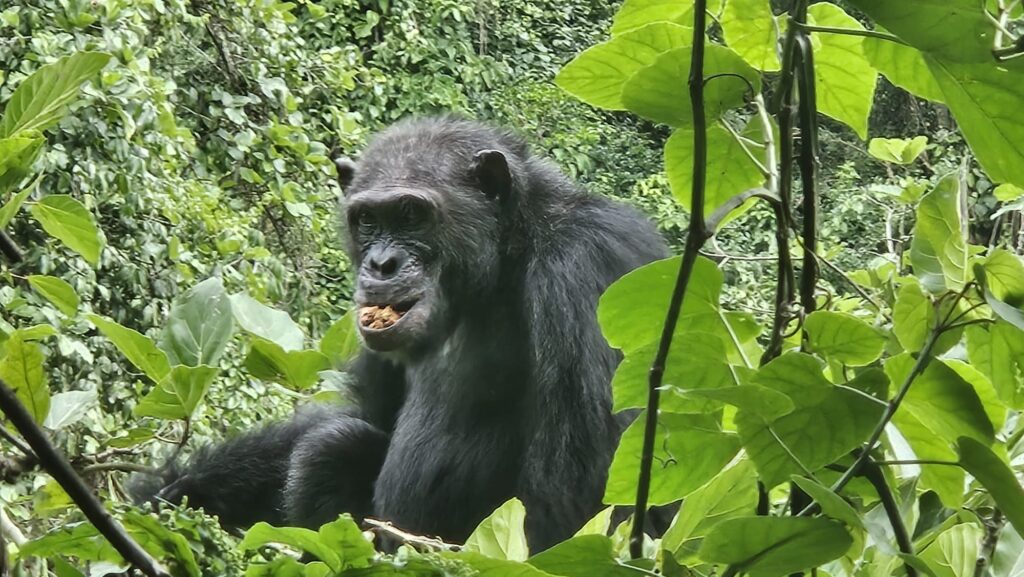
They have three meals a day, our other ranger, Judy, explained. And at the time of our visit, 3pm, they were already having dinner!
I was amazed at how close they got to us. Little I knew that, two days later, though, with the gorillas, we got even closer! So close that one gorilla even smacked me…. But this is another story 😊
Like with the gorillas later, we had to follow strict rules. We only spent 1 hour with the chimpanzees.
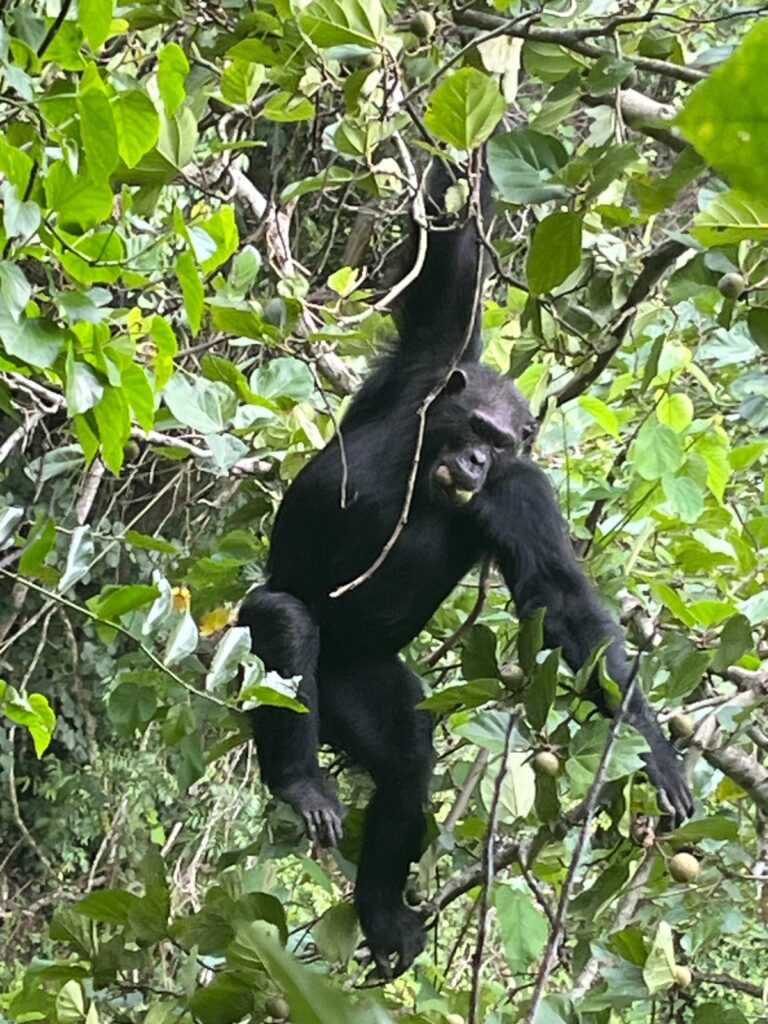
It was enough, though, to marvel at their dexterity, at their movements, at how similar to humans were!
I had seen it already with the bonobos in DRC the year before, but this was a different experience altogether, since these chimps were in the wild!
Boat Cruise in the Kazinga Channel
Later we did a boat cruise in the Kazinga Channel, which connects Lake Albert and Lake Edward, flowing northward from Lake Edward into Lake Albert.
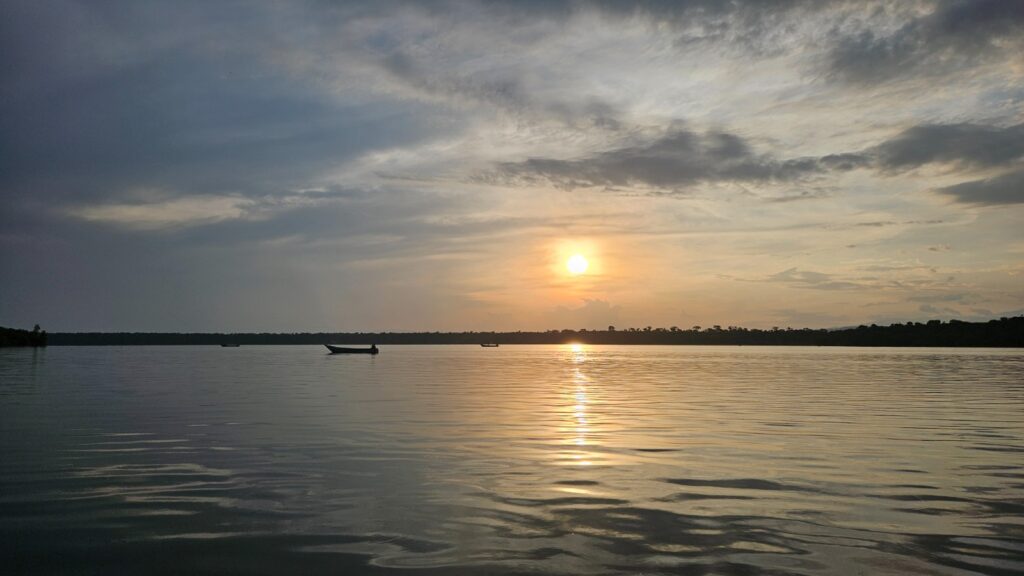
The Kazinga Channel is a 32-kilometer natural waterway which upports one of the highest concentrations of wildlife in East Africa due to its rich biodiversity and constant water supply.
Its shores are lined with papyrus and savannah, providing a perfect habitat for a wide range of animals, especially during the dry season when water sources elsewhere become scarce. And we experienced it first hand when we saw an elephant right there!
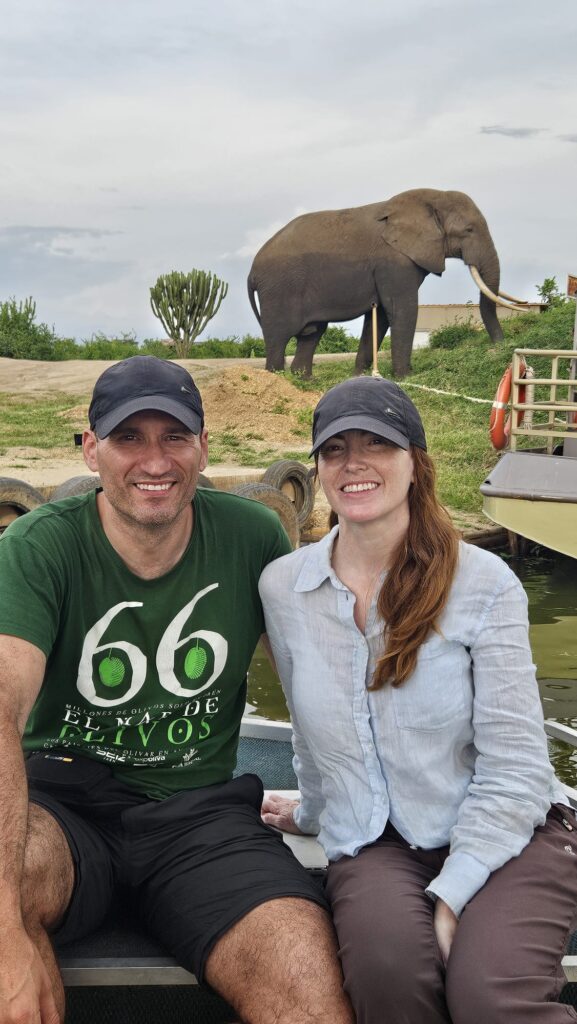
The channel is famous for its large population of hippos, often seen basking or partially submerged in the water to keep cool. And we were also testimony to it!!!
The shores also attract elephants, buffaloes, and antelope species such as waterbucks, all coming to drink or bathe. Birdlife is especially abundant, with over 600 species recorded in the area, including African fish eagles, kingfishers, and pink-backed pelicans.
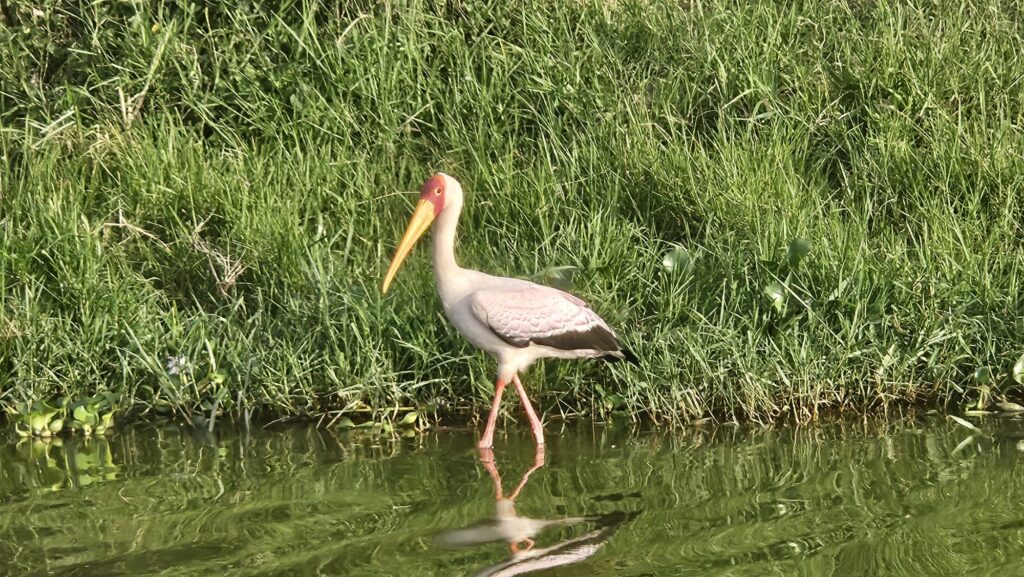
🦍 Our Mountain Gorilla Trek 🦍
For our gorilla trek, we drove down to Bwindi Impenetrable Forest.
The name kind of says it all – it is truly a deep and scary forest, quite scary.
I will never forget the scenery, with its lush green mountains covered in mist. No wonder, the forest is very close to the scenarios for “Gorillas in the mist” (I explain more about the movie and the story of Dian Fossey in my Rwanda post).
I will treasure the sound of the birds and insects, the leaves moving with the air, the smell of wet earth… every single detail that made me feel inside of an adventure (almost) worth of a National Geographic!
Bwindi Empowering Women: Ride 4 a Woman!
Before the trek, on top of giving us a brief, we were delighted by a group of very gracious women who danced for us.
They smiled and danced with remarkable energy, jumping and stepping down with both feet making a very loud noise.
I loved the show and also, I was super interested in the project they represent: “Ride 4 a Woman“.
A project that helps women in need and empowers women in the community, founded by a local who learnt how to fix motorbikes and later to quilt (helped by an Australian tourist).
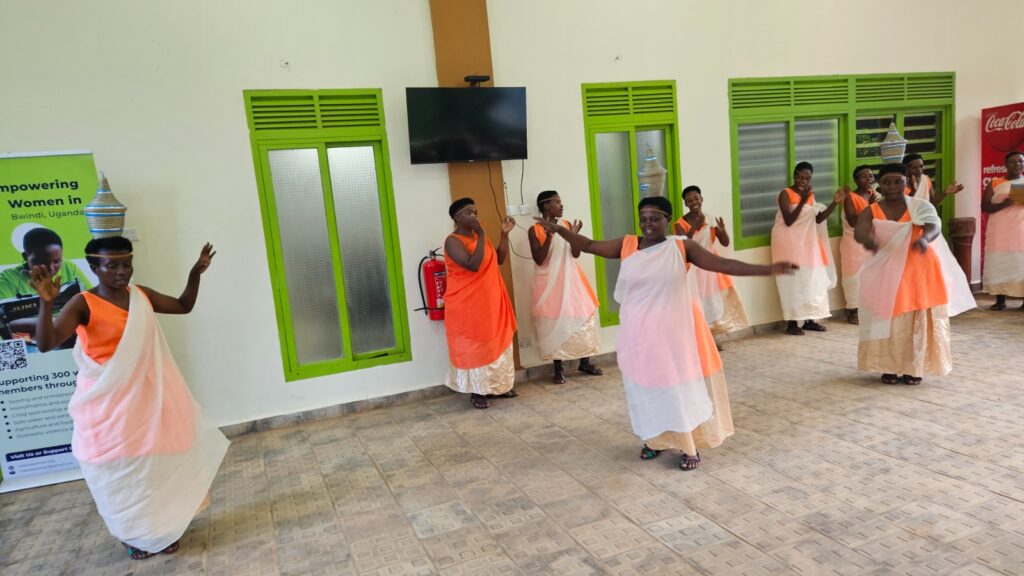
A very remarkable story and a project worth helping. Plus, you can choose how to help? You can “sponsor a goat” for 200 USDs!
Be prepared and know what to expect
The trek is not easy: it can take up to 6 hours and it can be very steep. Luckily the rangers make sure to warn you in advance, so you know what to expect.
You need to carry 1,5 litres per person, your packed lunch, long socks, long sleeves, trekking shoes… and, like with the chimpanzees, a mask. You do not want to give the gorillas the flu!
There is a ‘porter’ service – for 20 dollars, a local will carry your bags.
And, what surprised me the most, there is even a ‘stretcher’ service: they can take you with a stretcher for the price of 300 USD. My gosh, that gave me a vibe of a “vintage film” with white explorers…
They minimise the disruption
Here they take good care of the gorillas.
I really liked the way it is organised. The rules are quite strict and allow for tourism to help protect the mountain gorillas, but not disrupt them.
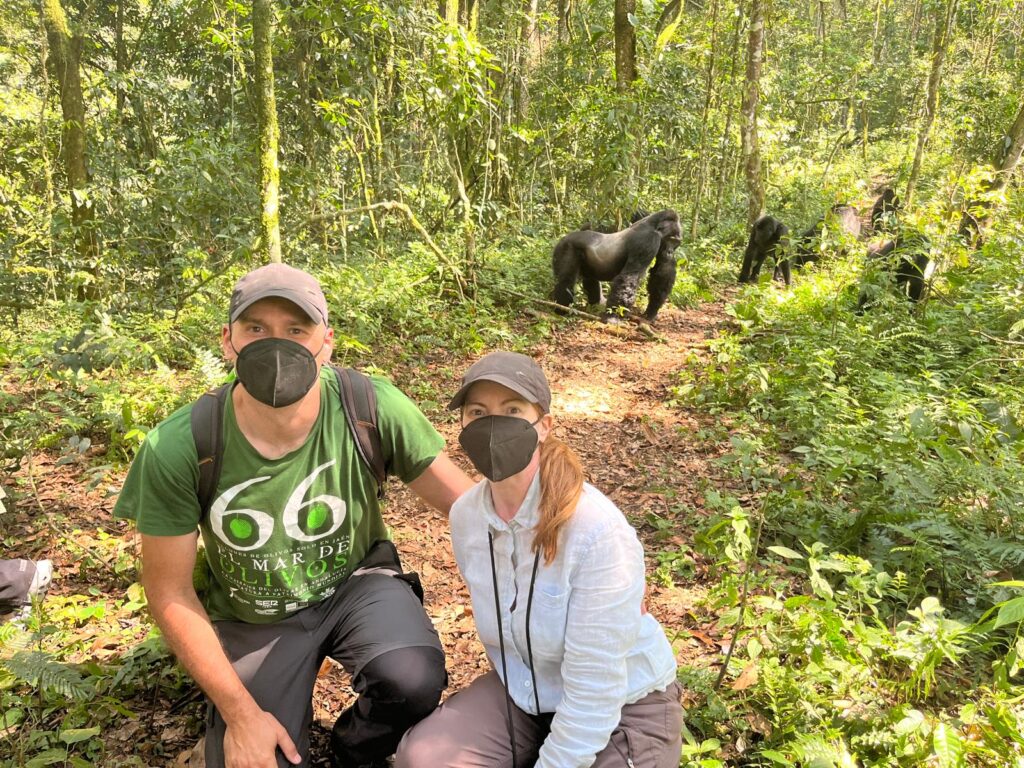
- Never groups bigger than 8 tourists.
- One group tracks one family.
- Everybody in the group needs to wear masks not to pass the flu to the gorillas.
- You can only stay 1 hour with the gorillas and they take this very seriously, so they do not get too used to humans.
And it seems that it is working! Our guide told us that, since 2019, 109 baby mountain gorillas were born!
How do they track them?
The mountain gorillas do not wear neck trackers, like the lions we saw in Queen Elizabeth’s Park.
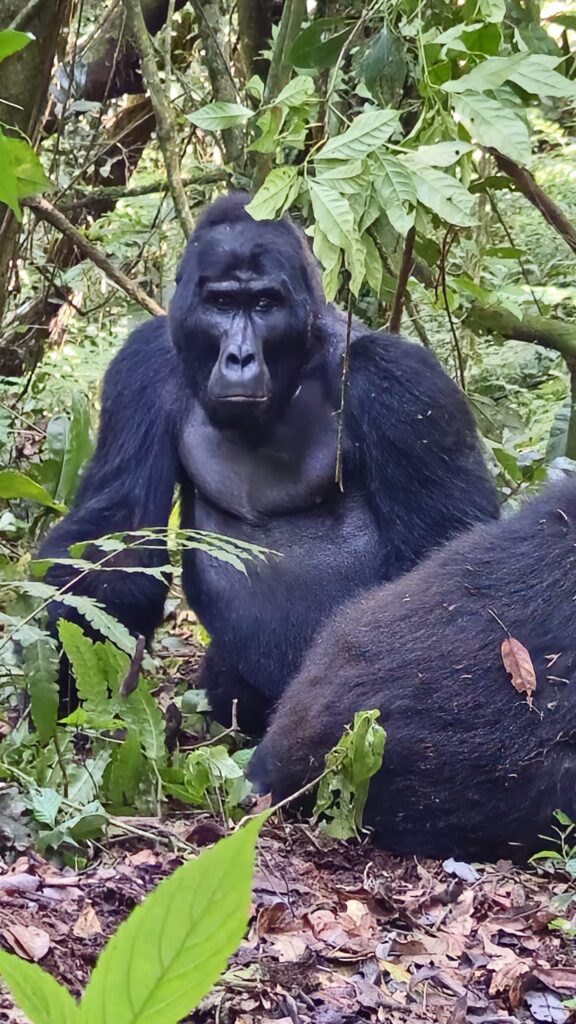
Every morning, the trackers get up very early and they head to the last place where they had seen the family the day before.
Then they follow the footprints and broken branches trail until they find the place where they slept: their 1-night nests.
And from there, they keep following the tracks until they find them.
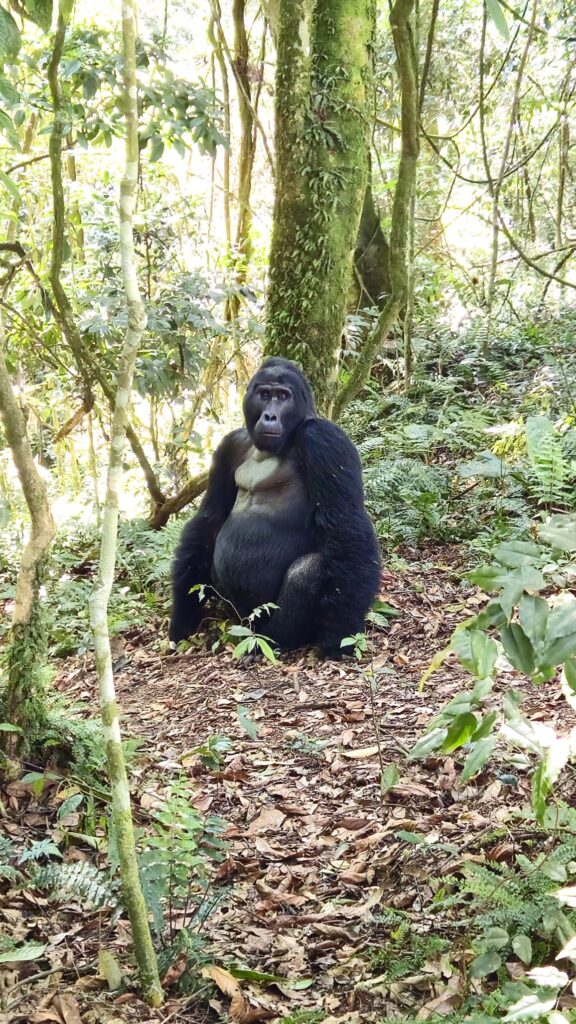
Our family: Cabio’s
We were very lucky and we found our family of gorillas, called “Binyindo Group”, just after an easy 30 minutes walk!
It was the most usual formation – 1 male.
Our silverback was impressive. His name was Cabio and he kept looking at us with eyes that looked too human! It was impressive and scary at the same time.
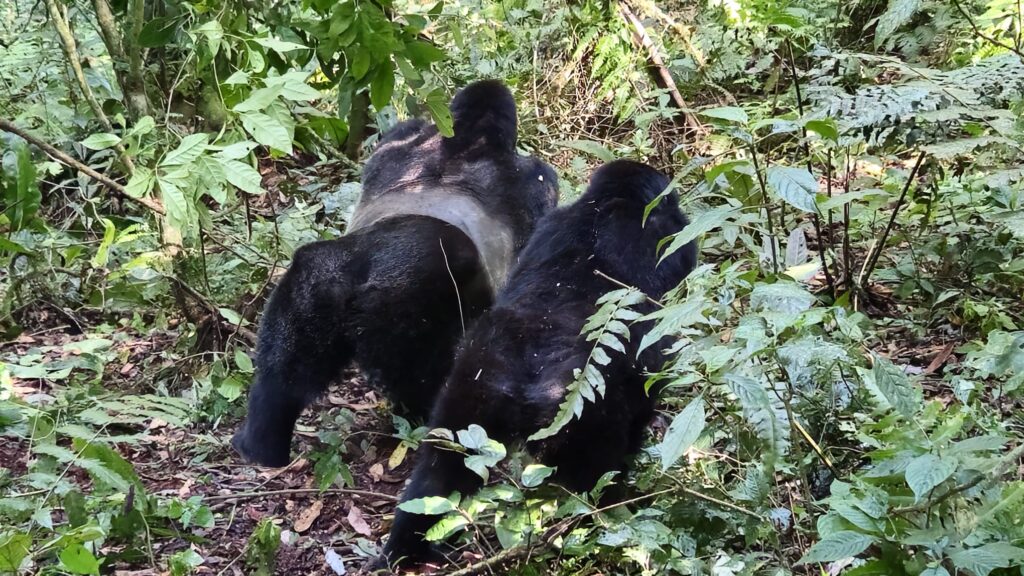
We spent one hour that felt very short looking at them grooming, being lazy…
But, my Gosh, when they moved, they did with surprising energy. One climbed a tree and a few branches fell down on us 😊
“Curious” facts about the gorillas – too much information?
Our guide, Juve, a ranger who had been doing this for 7 years, explained to us many facts. Some of them we experienced first hand.
Like, for instance, that they fart. And I can tell you: they do! And the smell is out of our human league!!!
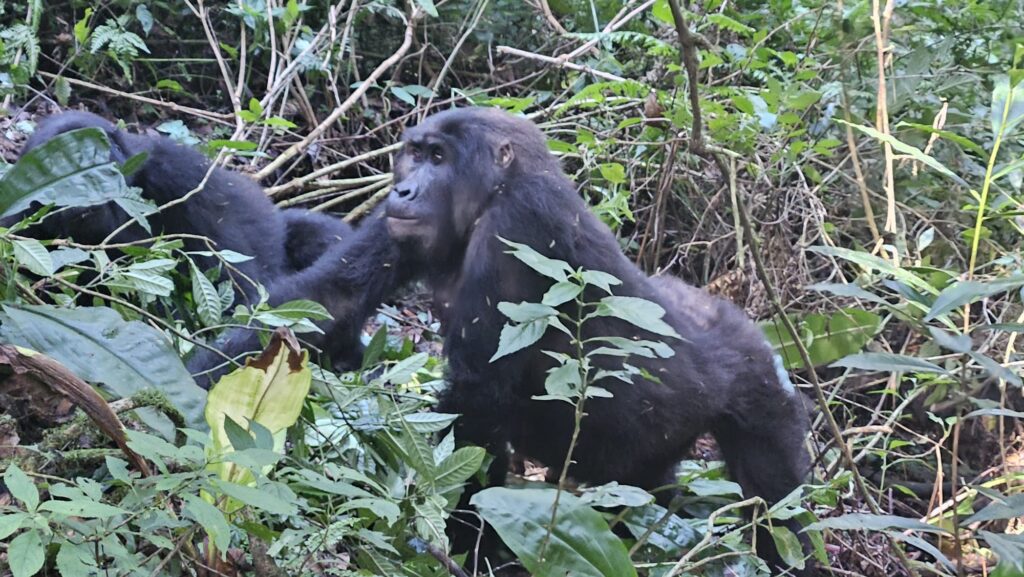
They never sleep in the same place, and the trackers recognise the individuals by.. the size of their dung!
☠️Too close for comfort! I get smacked!!! 😧
Seeing the gorillas so close was an experience I will never forget. It was not even 2 meters, and when they moved, they got very, very close…
It looked like we were part of a film, a documentary, but alas! No. When we were leaving, as both Roger and I were taking videos, a female gorilla came closer to me and very fast, smacked me in the leg!
That I will never forget either! I have the image of her long hand reaching out to me! First she picked a branch, and later, she smacked me.
An american girl in our group got it on tape: here’s the footages of me being “attacked”:
I was not hurt, but quite shocked.
A reminder of how agile, how powerful, how energetic they are. This is not for the faint hearted!
🏃♀️ The Race 🏃♀️
Before the Race 📧
A week before the marathon we received an email with the last details, which was super useful as it gave us time to prepare. The email contained information about the race:
Race Day Highlights:
- Date & Time: Race activities kick off at 6:30 AM at Ssaza Grounds.
- Race Kit Collection: You can pick up your race T-shirt and race number at the race venue any day until the 29th, between 9:00 AM and 5:00 PM.
But, most importantly, it highlighted how to Make an impact:
“Your presence means the world, and so can your support. The Uganda Marathon champions several incredible community development projects, and you have the opportunity to contribute in meaningful ways.
Please visit our project page here:
https://www.givengain.com/cc/the-uganda-marathon-community-projects/“
Race Briefing
The Race Briefing took place in the hotel Brovad, where many international runners were staying.
We stayed in a hotel very close, the Maple Leaf hotel, so we walked there.
The Race Briefing took place on a sunny afternoon, in the garden next to the pool of the hotel. And Moses, the race director, introduced us to the international crowd.
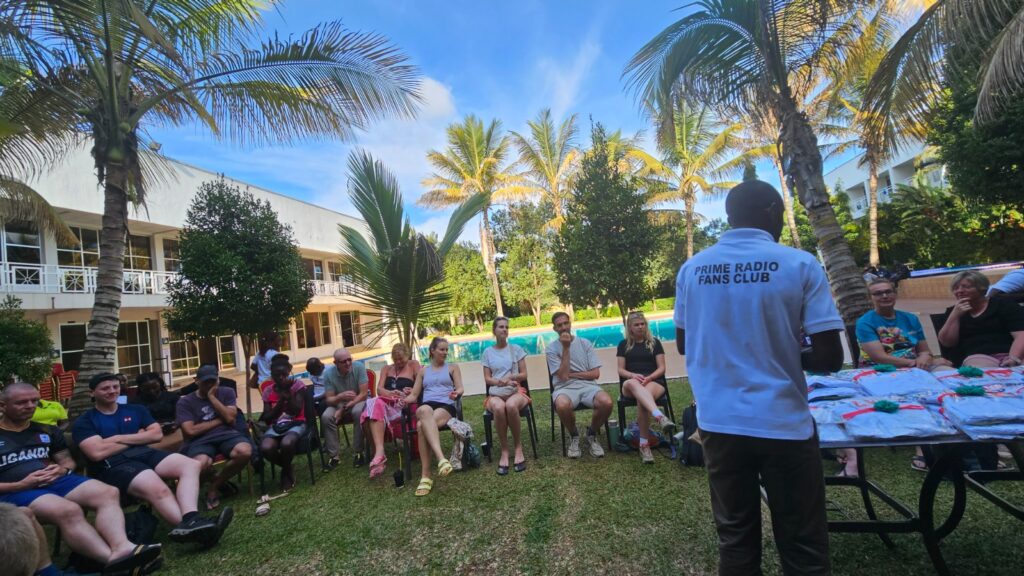
There were about twenty to thirty runners from all over the world, looking very similar to the ones that we have encountered in other races in singular locations: people looking fit and trim,tanned (or burnt!), with good Garmins in their wrists and sporting caps and t- shirts from other marathons.
Curious instructions
Another race ranger gave us very funny instructions, which were very different from other marathons and proved that the day after was going to be “an adventure like no other”…
- “Take your time”
- “Take toilet paper and 50k shillings” -?!
- “Run the distance you want”
- “Don’t look at your watch”
- “Local kids will be running with you”
- “There will be toilets and letrines at the start and finish, but when you are out there, just be creative”🤣
And more standard ones 🙂
Other instructions and general information were more “traditional”:
- “Listen to your body”
- “There will be a medical tent where even massages will be given!”
- “Glucose and salt will be provided”
- “There will be transport to go back to your hotels”
And something quite curious:
- “You can throw your plastic bottles. Normally we would not encourage it, here people recycle them and make some money out of it”.
It was also interesting when a doctor participating, “Doctor Sarah”, with a UK accent, was asked by Moses about the most common problems for this event 😰, and she listed:
- Dehydration.
- Heat stroke.
- Unbalance in your bodily fluids. Drink but just NOT ONLY water.
- And, also… twist your ankle!
Race Kit
The race kits for international runners included a white T-shirt and an ‘explorer’ cap with the Uganda flag which looked to be very useful in these latitudes!
But we only got the T-shirt as we had only signed up for the race and not the whole 1-week experience 😭. We didn’t mind much, to be honest.
Race Day! ⏰
It truly was a great experience which I highly recommend. It gave us a taste of the local life in Uganda, with the festival full of locals and all the schools featuring, dancing and singing traditional songs.
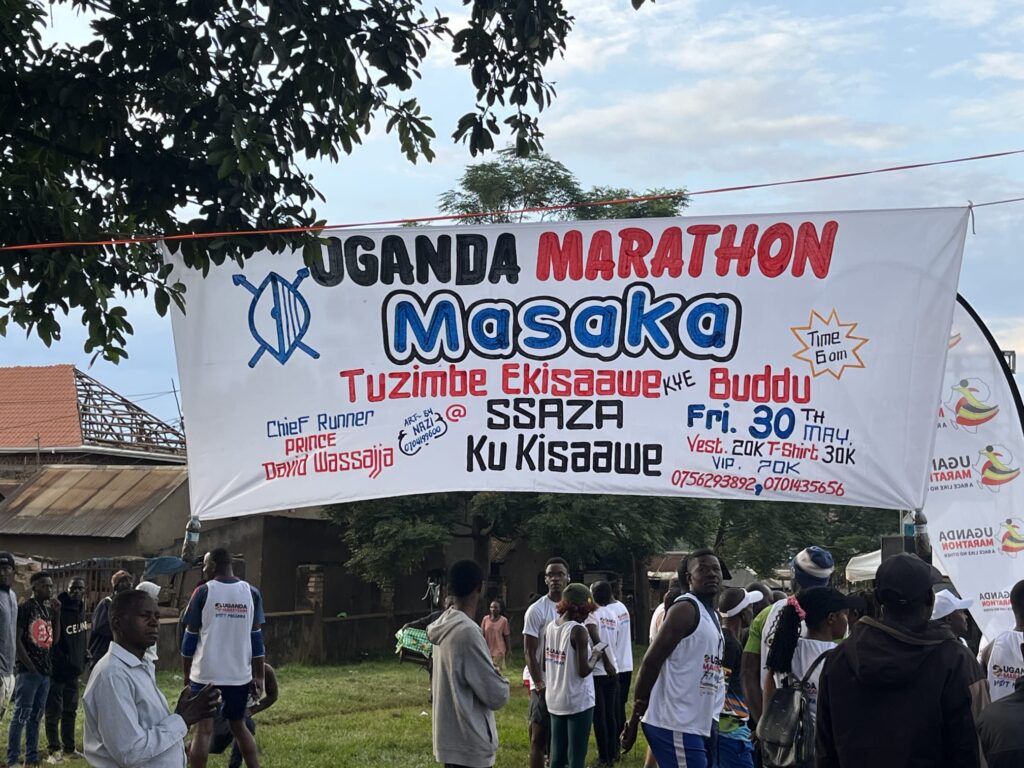
We mingled with the locals, spoke about the race and what brought us here, we ate local food and took a lot of pictures with kids, who smiled happily.
Oh, and the race? That was brilliant too!
The outfit: Groom and Bride 🤵👰
I had planned to run in full white, “like a bride”, veil included. And the idea was that Roger would wear a bowtie 😂, since we got married only a week before.
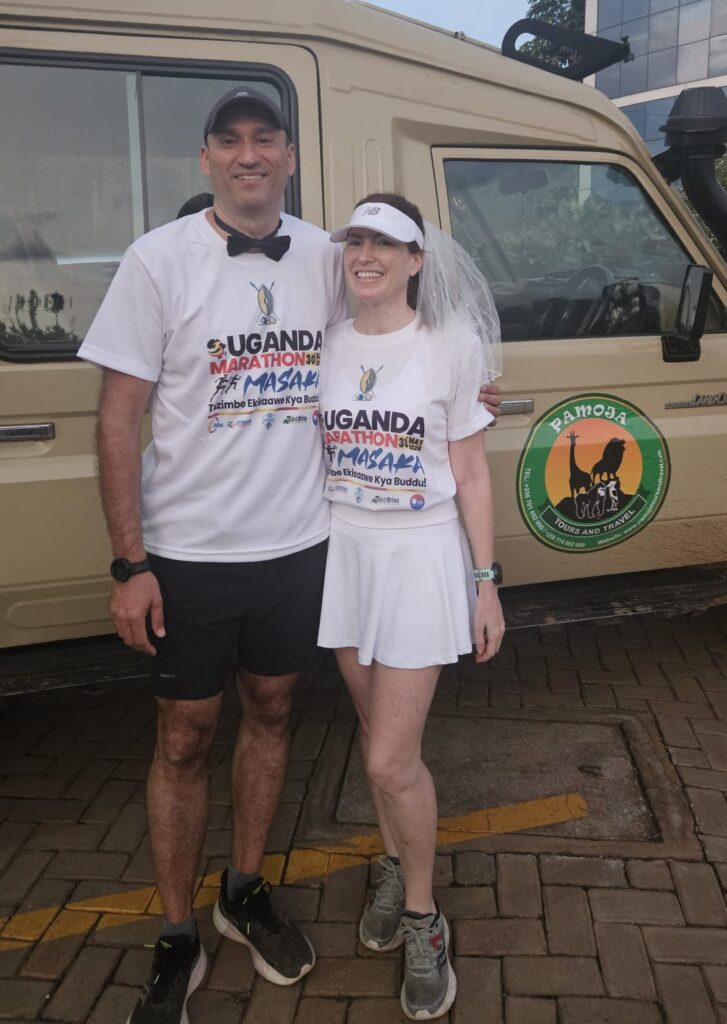
I bought all my white attire, but at the very last minute I decided to wear the Uganda Marathon t-shirt since… It was also white!
I was pretty lucky there because this way I could dress as a bride but still sport the race t-shirt!
So, dressed as groom and bride we headed to Ssaza Grounds, where the marathon was starting.
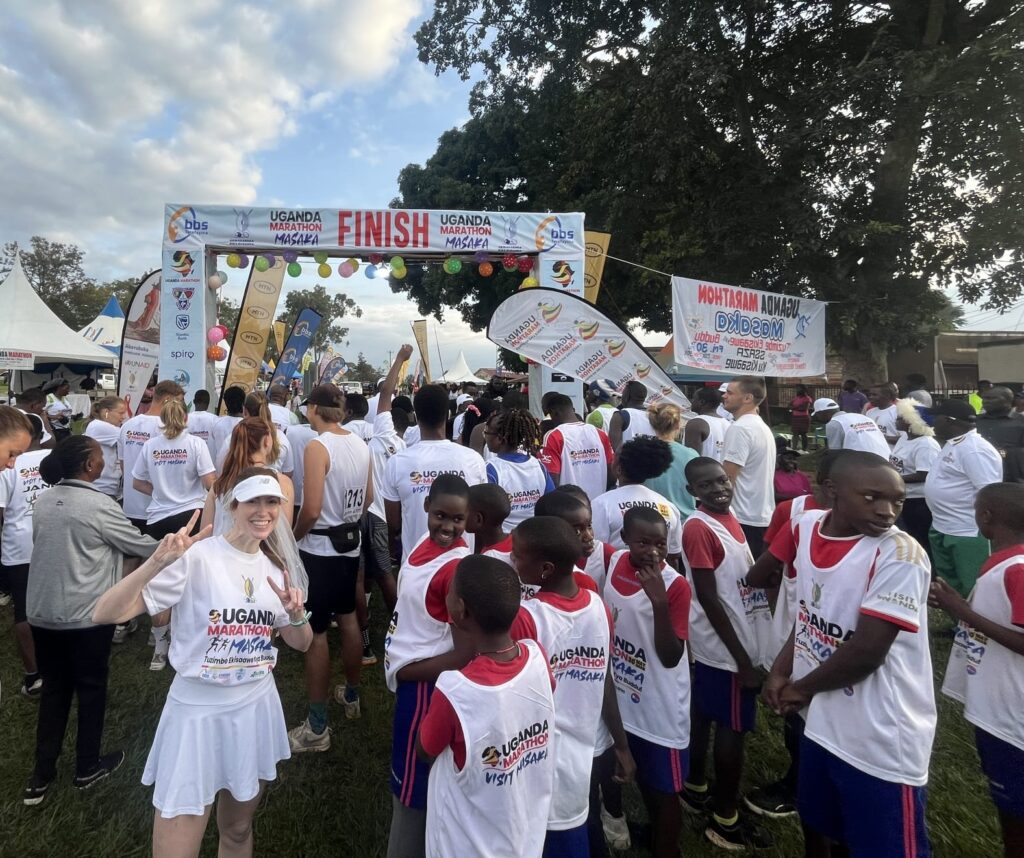
Getting there
The day before Moses had said that the 10k would start at 8am and the 5k at 8:10, but Leticia, our guide, who was “communicating with them” (slang they use here) told us that we should be there at 6:45 as everything was starting at 7am.
I wasn’t sure but she turned out to be right.
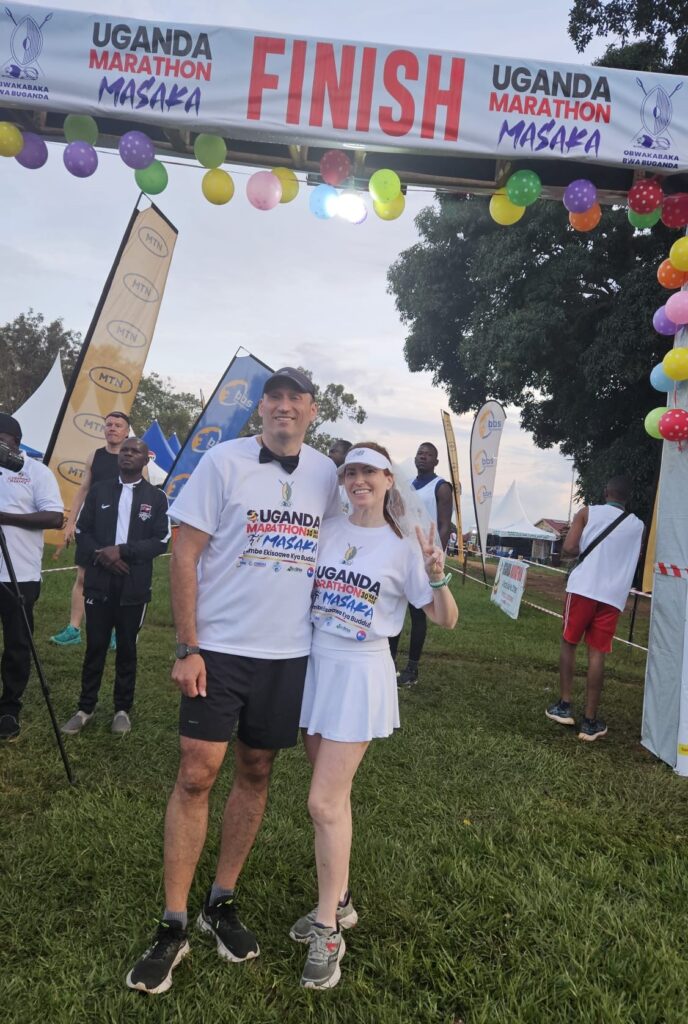
This was Africa and timing (and distance) seems to be always relative.
It was great to arrive at 6:45. We had time to enjoy all of the activities!
Ssaza Grounds
The start and finish line was located in a large ground covered in green grass and had a lot of facilities. There were toilets, tents for massages, breakfast, medical staff, etc.
Also a lot of chairs covered by additional tents.. which proved useful later when it started to rain.
Everybody looked happy and we started taking pictures with many locals. My bride veil proved a great success ☺️
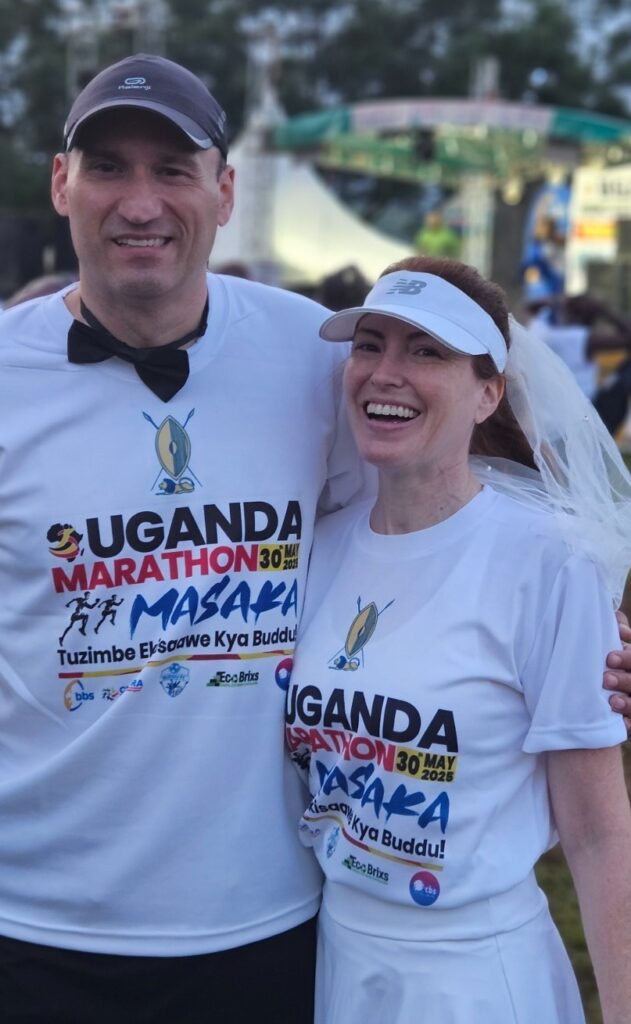
Warm Up
A very fit instructor was directing the warm up exercises from the stage and many locals were following him with surprising rhythm and energy.
The music was extremely loud but, as Leticia already warned, “everything is so noisy in Uganda”. And I loved the selection, which was quite FIFA world cup oriented and it brought me so many good memories!!
They played “Waka waka” and “Wave your flag” (both from Africa’s 2010) and “Arhbo” (from Qatar’s 2022).
There were already a lot of people, almost all of them wearing the white t-shirts and vests, music was playing and it all had an energising atmosphere.
Roger and I tried to follow but Roger even commented: “We are going to get tired before the race!”. Still, we had a lot of fun “dancing” with the locals!
Start of the Marathon and the Half Marathon with a prince!
Then the marathon started promptly, at 7am. The speaker, speaking in English, mentioned that “we want them to avoid the heat”. That was kind 👏
It looked like it was going to be a sunny day. But, actually, later it turned out very rainy!
Most of the international runners ran the full marathon, with a few running the half and the 10k. We cheered them as they left! The atmosphere was so festive!
A few minutes later the 21k started too. We watched it with Leticia who explained to us a lot of gossip about David Wasajja, who is… a prince! She told us he had cheated death when his boat capsized…
If we had run the 21k, we would have the opportunity to run with a prince, who would have thought?
He was announced in all the banners as “the chief runner” and given he is the King of Buganda’s brother, one can understand why.
We decide to run the 10k
The 10k and the 5k started later. For a while the speaker talked in a local language (luganda) mixed with some words in English. This seemed very common: during our time in Uganda I heard our guide and many others maintaining a whole conversation in luganda and using English words in the middle. We heard “10 kilometers” and “slowly slowly” while we were doing some stretching.
Then Roger suggested “we could run the 10k…” and of course, I jumped at the opportunity as I wanted to check how well we would fare in a longer distance. And because I just love running!
Start of the 10k
The start was brilliant as there were so many locals cheering! Also it was downhill.
We ran along the streets already full of people and shops and motorbikes. The motorbikes going in all directions turned out to be constant during the whole race.
Obviously, streets were not cut to give way to the runners. This was running immersed in the life of Masaka on a Friday morning.
So we continued downhill in a red earth path surrounded by precarious housing and curious locals who kept looking at us while preparing something to eat and dusting off the entrance to their homes, some of them not being much more than huts.
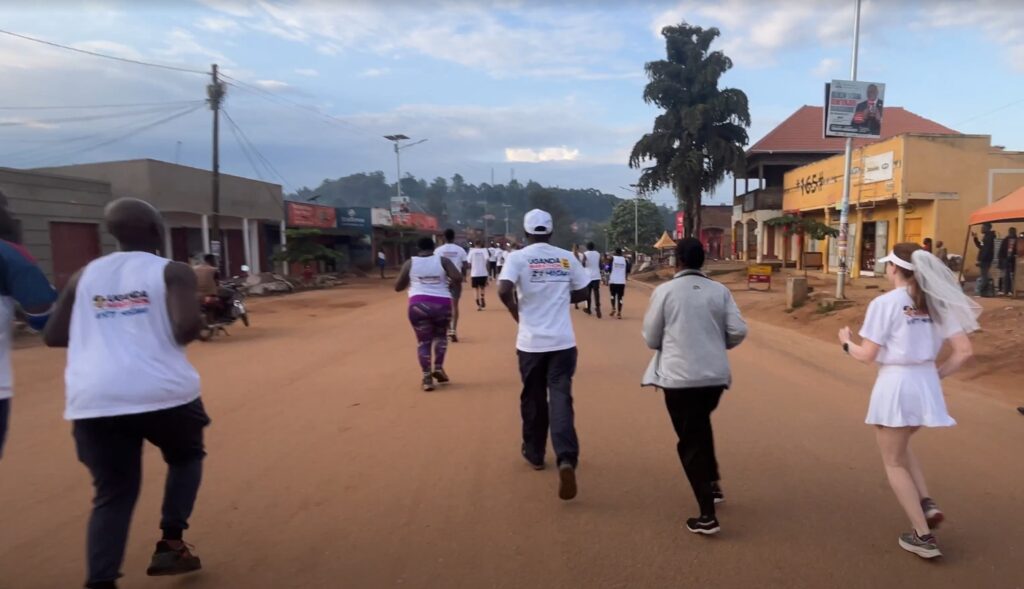
The weather: It was crispy, perfect for running, and the air was clean and just filled with the smoke of some domestic fires, as we were off the main streets.
Crossing roads and more paths
Then we crossed the “main road” that goes to Kampala. A marshall and some painted arrows in the asphalt showed us the right way. But at this point we were still surrounded by other runners so we didn’t fear getting lost.
On the road, the students inside a School Bus rushed to the windows to shout “Hello!” and cheer for us. It was super cool!! 👏👏
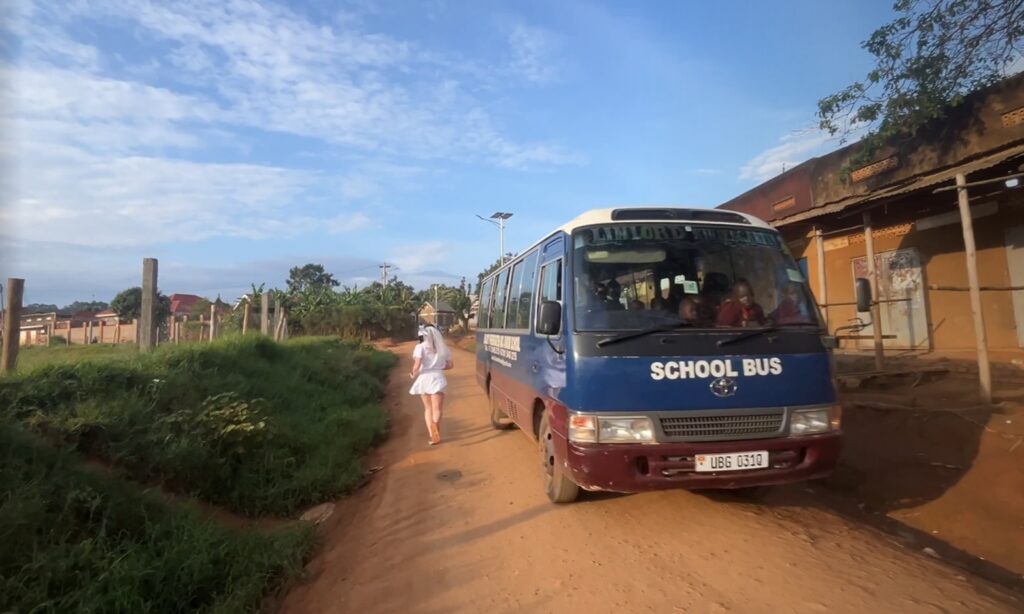
After the road, more earth paths and running through semi rural areas, but this time, uphill…😅
It was kilometer 2,7 and some runners started walking 🤫. We ran, but as we had not carried water with us, Roger told me to “take it slowly“, and I did. I was feeling strong but followed his pace not only to be cautious with dehydration, but also as this was going to be my first 10k after surgery.
I remembered Moses’ words the day before. “Do not look at your watch, just enjoy!“.
I loved this part for its atmosphere, a part of the city where tourists normally do not venture into.
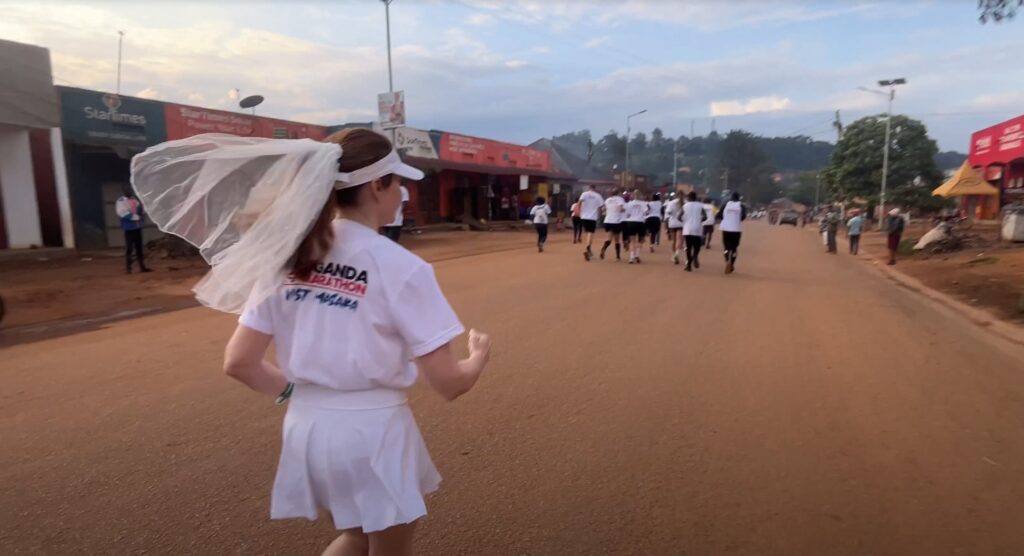
And here, a young man passed us running at a good pace.. in loafers!! 😲
Midway
At kilometer 4,9, I started hearing shouts which I did not understand and turned out to be “Water, water!“
An ambulance was handing over bottles of water and glucose. Roger took one bottle and I picked mine from the ground as I didn’t catch it 😅🤣.
Roger later made fun of me, calling me “Marcus Brody” (the character in the Indiana Jones movies) as I seem not to understand anything and get lost everywhere!
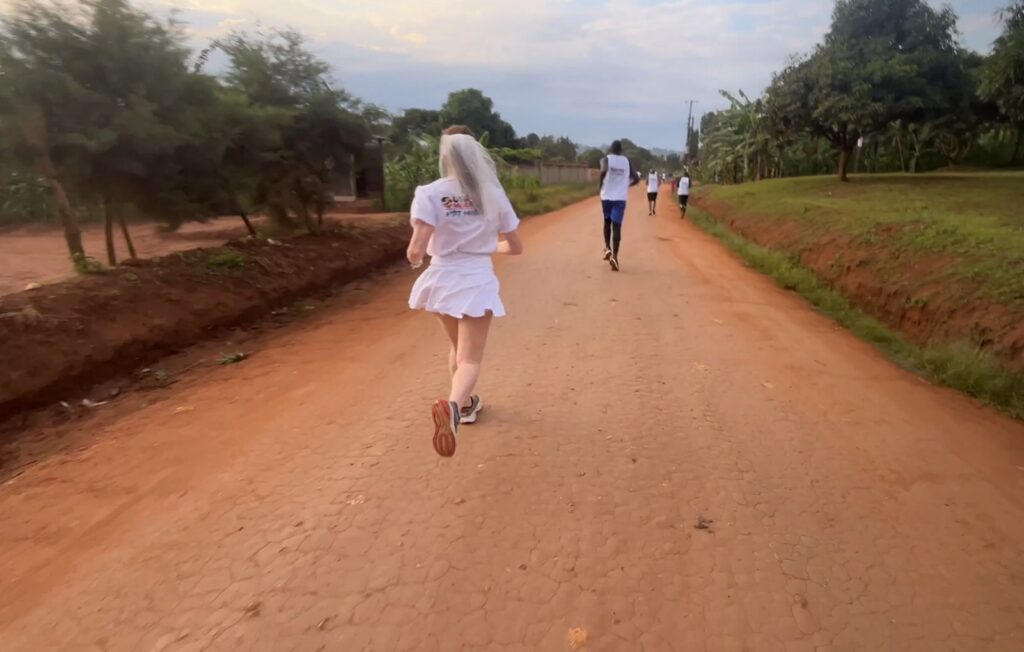
We had reached the top of a hill. In a nearby massive school with many buildings echoed the voices of students reciting its lesson. I thought of the book I had been reading the night before, “Our lady of the Nile“, which takes place in a boarding school in the Great Lakes Region. For me, a European, it was evocative and exotic.
And the landscape..! Oh wow 🥰
Hills
For the next kilometers we went up and down very steep slopes! Some looked almost vertical in front of us.
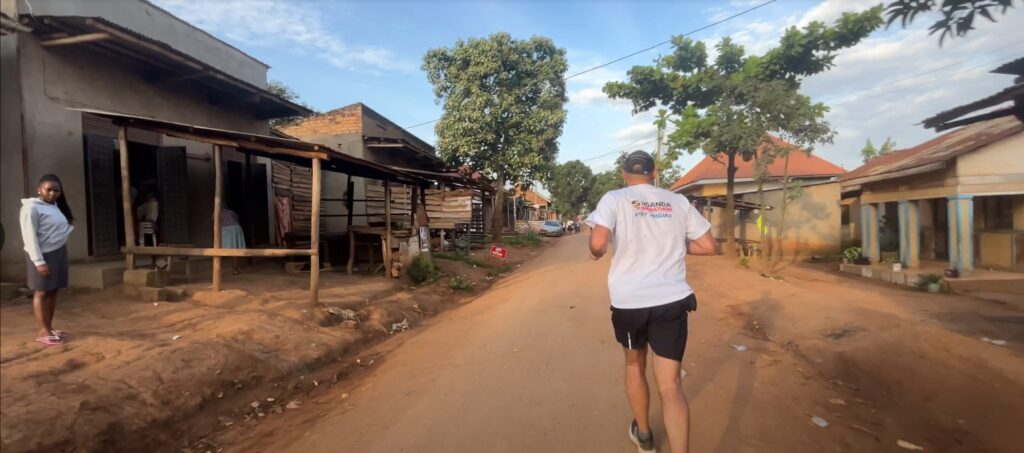
In one of them, Roger took a video of me running down, and luckily I did not fall, though I picked up some speed and the terrain was uneven and I can be quite clumsy!
After a couple more slopes in semi-rural areas, with animals crossing paths with us (dogs, chickens, cows…), we reached “the city” again at kilometer 7.
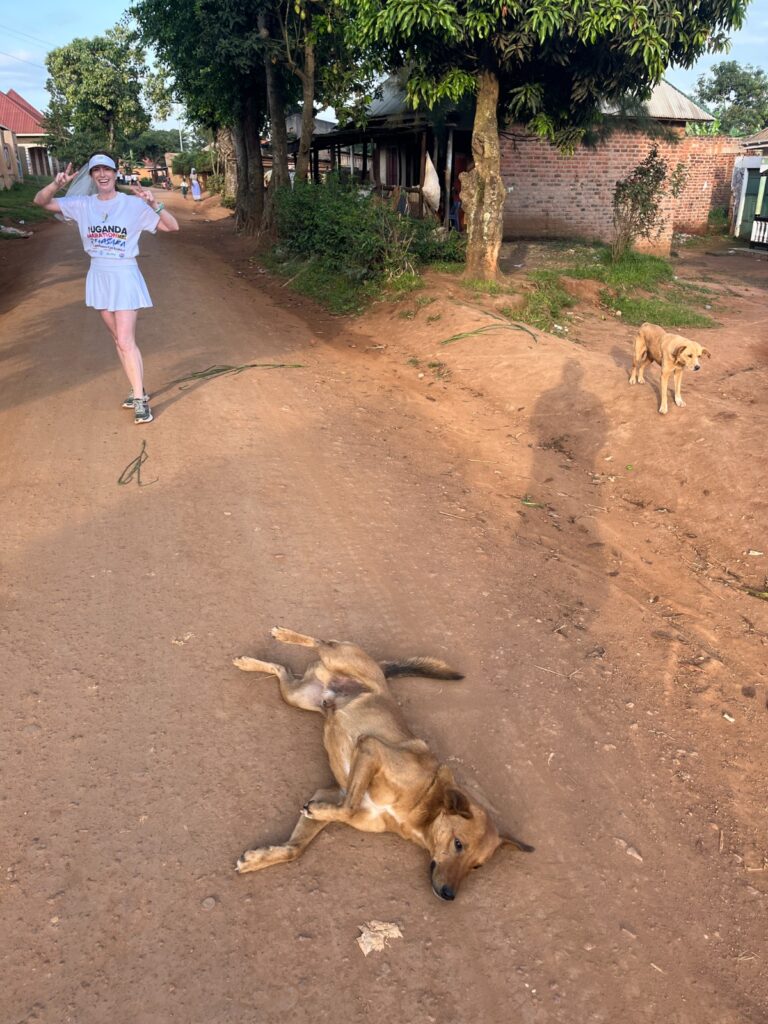
Back in Masaka centre
We passed by a zone with a big pyramid of massive bags containing empty plastic bottles to be recycled on our side, and piles of wood for construction at the other.
Here some groups of locals were already working and some shouted at us and smirked (I am pretty sure they were making fun of us 🫣).
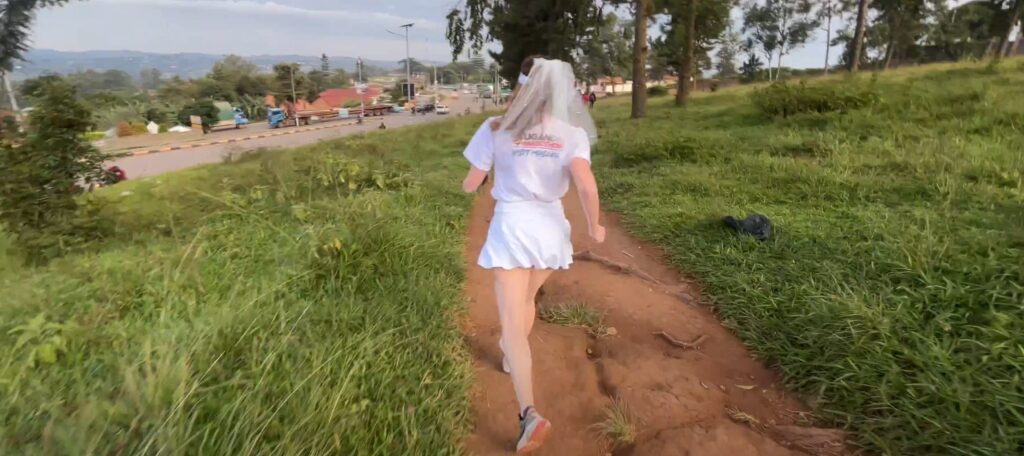
Later we passed two roundabouts, where marshalls showed us the way. One marshall signalled us a road up and Roger joked about it: “Oh no, not up!” and made the marshall smile 😇
Local market
Then we reached a local market. The sun was shining but as we were running in a street with ‘tall’ buildings that casted shadows and it was ok.
The market was already busy and we heard shouts and cheers amidst some loud music being played. I think that a local even tried to sell us something!! 🤣
I thought he was crazy but alas! No. Leticia told us she saw many international runners stopping and buying things. And I remembered that Moses told us to bring 50k shillings “in case you want to buy something to eat in the street stalls“.
I wonder how my stomach would react to local food 🔥 and running 🏃♀️. It seems to me like a very dangerous combination! 😝 But I guess that some runners want to take the “adventure like no other” to the extreme…😅
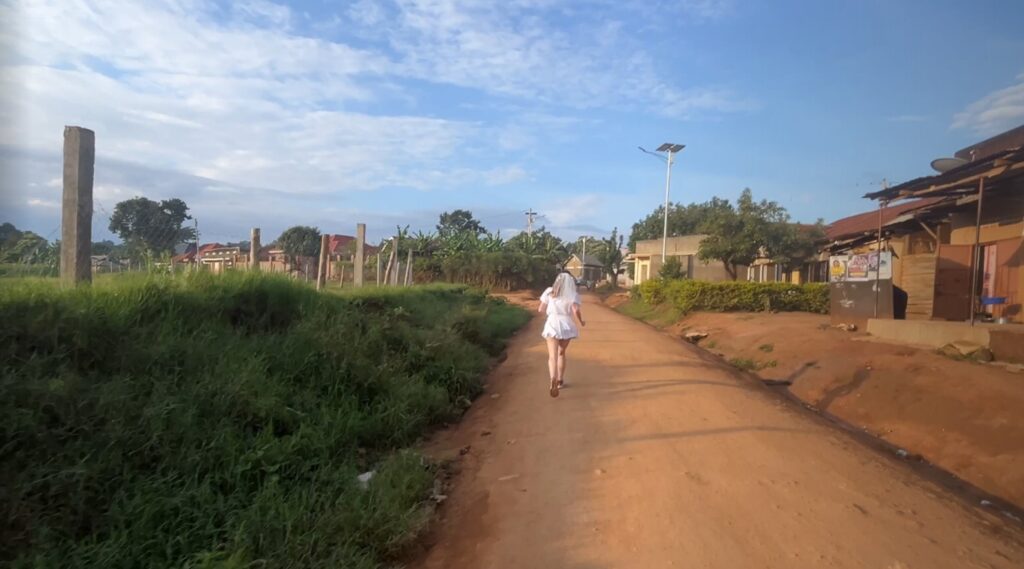
We continued running and I watched the trading. A couple of young guys looking through a pile of jeans Next, another pile of blouses was being scouted by a tall and strong woman with braids.
The buildings, with metal balconies, were completely covered by ads, of all kind of items, very random: telephony, dental clinics, tire repairs, pepsi…
I observed it all, how frantic, how African, colourful and chaotic and noisy and lively, and couldn’t help but mention to Roger how lucky we were to be experiencing this! 🥰
We got lost!
After the market we continued on to enter the part of Masaka where our hotel was.
For half a km we were running on a foot path amidst vegetation a few meters over the busy streets. There we crossed paths with two very well groomed students and a business man looking smart in a blue jacket and brown pants.
Many Africans dress extremely well, in places where you least expect it!!
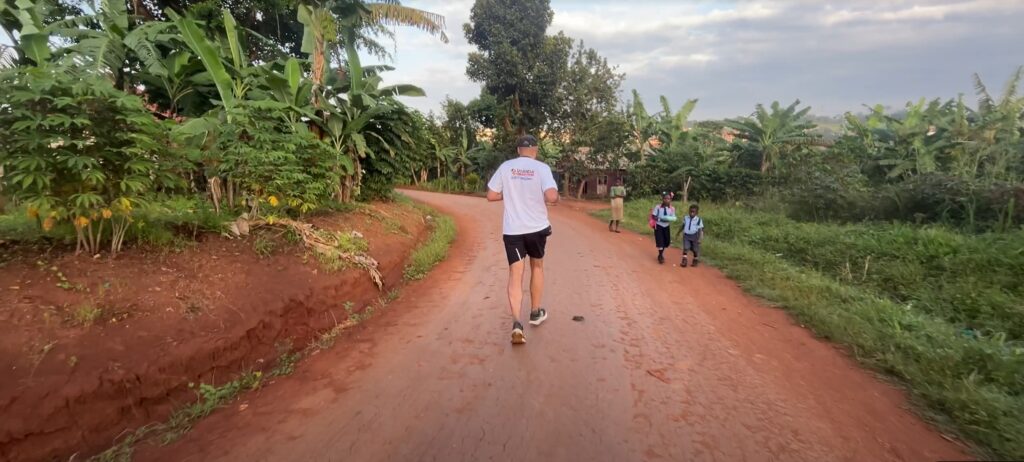
We were already at kilometer 9, and by then we had lost most of the runners but a couple of young locals, about 12-13 years old.
We followed them and ran with them. I asked one of them: “Do you know the way? ” and he was positive.
Turns out they got lost so we got lost too.
By the time Roger looked at Google Maps, we were at km 9,8 and we still had 1,5 kms to go!! 🫣
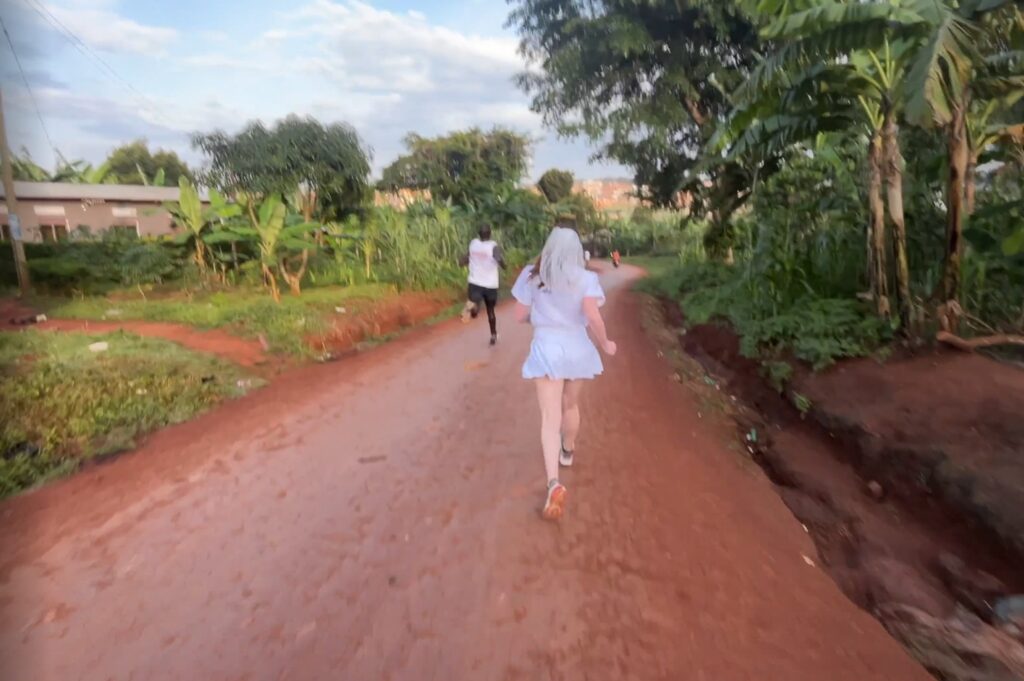
But we pressed on happily as well, this was not about the time, but about the experience.
We realised we had screwed up when we saw a white girl coming from the right course 😅😅 Then we overtook her, now running at a good pace.
The Finish!
We ran the last km slightly faster. We also overtook a very well groomed local who told us “You guys are fast!“. We weren’t really, but Roger answered “I just want this to stop!” 🤣🤣
We could hear the music. A turn right and dozens of school children, some dressed in traditional attire but most of them in the marathon vests, cheered and chanted and gave us a hero’s welcome!
A motivated photographer jumped off the back of a motorcycle in front of us in time to take some pictures of us crossing the finish line.
We entered hand in hand, like we normally do, but this time it didn’t feel like an accomplishment, as I was not tired (11,2 kms at 6:35 pace 😇🤣😅), it felt like another angle of the adventure, another part of the experience.
After the race
We got as many bottles of water as we wanted and a little sugar. A guy was pouring sugar from a plastic bag into our hands 😲
And we stayed for more than 3 hours on the site, watching runners arrive, talking with the locals, dancing and watching the show.
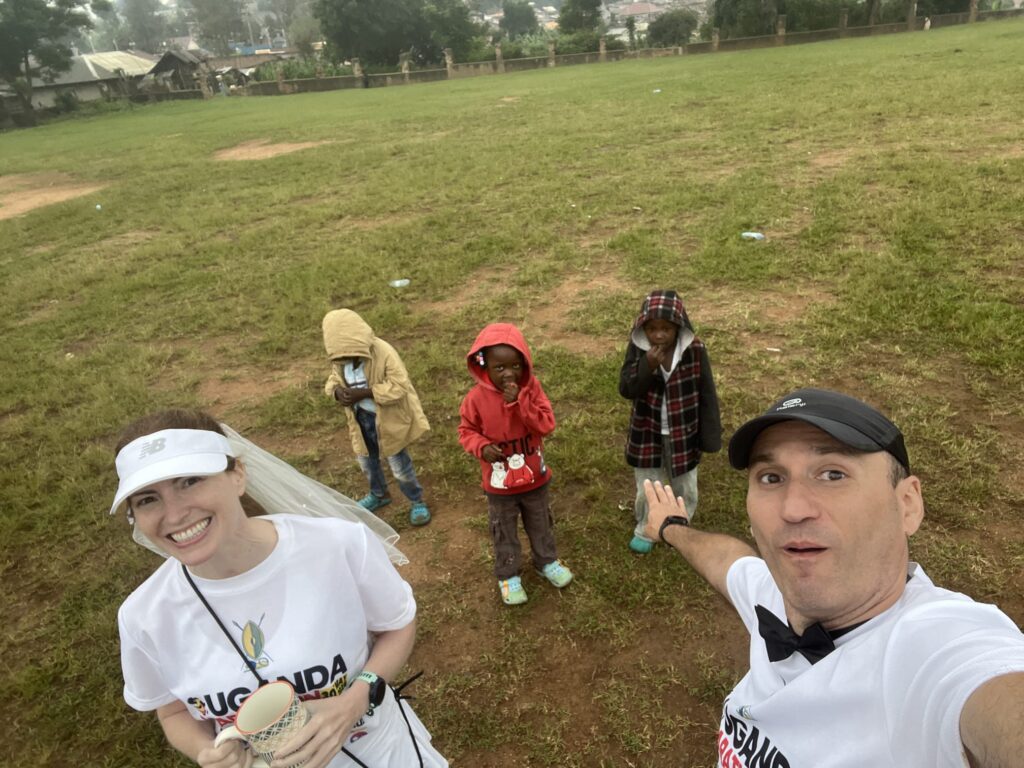
More dances and singing on stage, and groups of kids on the ground asking for pictures with us. We especially enjoyed talking with a group of girls from the Masaka Nursing School and with a teacher who turned out to be the winner of the 10k!
The winner told us that he didn’t think the course for the 10k was actually 10k. It might have been more… or less. Because, he explained, the African runners took shortcuts and in general, “designed their own race” 😂
VIP Breakfast
We also could join the “VIP Breakfast” which, as announced in the email we got,
“As a special guest, you’ll be treated to a beautiful and energizing breakfast after the race – a small token of our gratitude for choosing to be part of the Uganda Marathon family.”
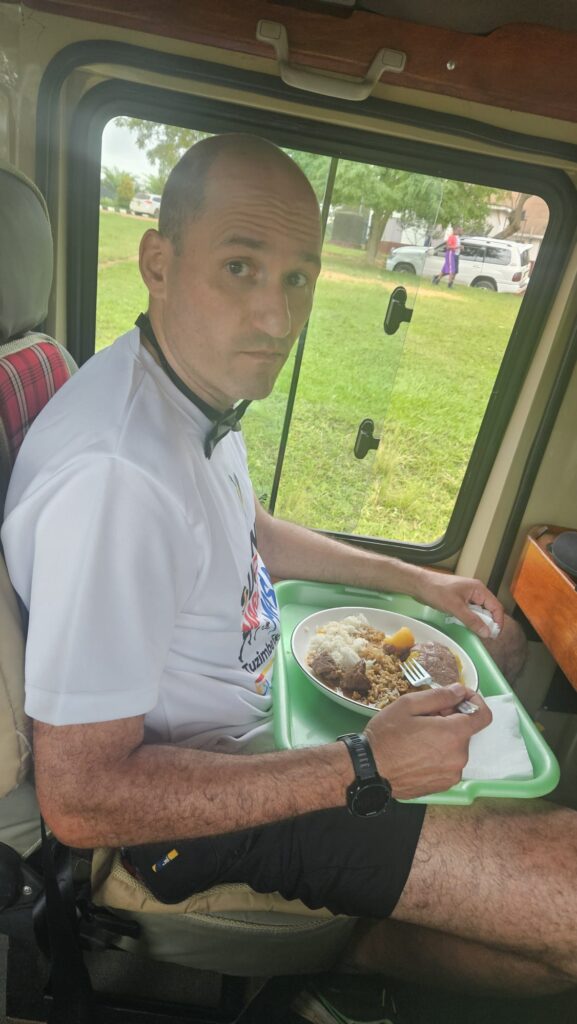
By that time, it was starting to rain.
We were experiencing the African climate, so changing!
So we ate our breakfast, consisting of typical Uganda food – potato, rice, meat stew and the banana – inside of our car!
Last impressions
As we were leaving the side, while it was raining, we saw a group of international runners walking.
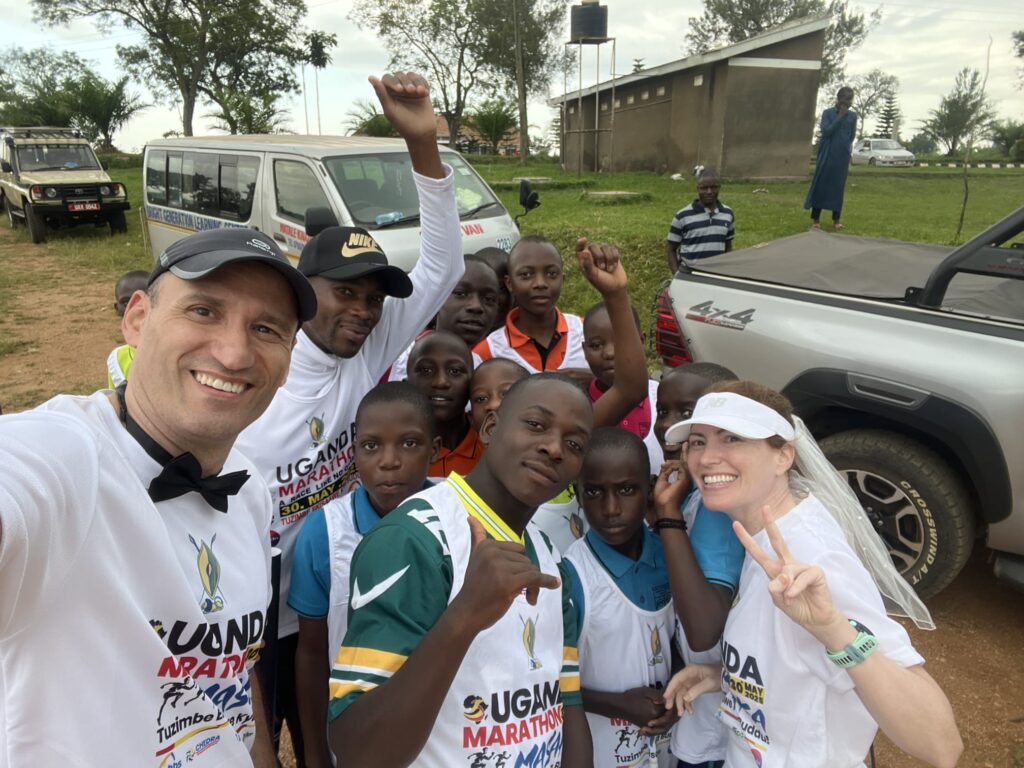
Apparently many of them just walk the 42 kilometers. I really felt for them as it was quite heavy rain, but I am also sure they would not mind that much. They were probably happy to be living this “adventure like no other”!
Later, as I was reflecting on what we lived in the hotel, while it was pouring down with rain and I had my memories still very recent in my mind and in my heart….. I realised: I felt so happy to have come!
🏃♀️ A Run amongst the Gorillas! A Run in Bwindi Impenetrable Forest 🏃♂️
Two days after the Uganda Marathon, we had the opportunity to run in a truly special setting: the Bwindi Impenetrable Forest.
A forest nestled in the heart of Africa, home to gorillas living in the wild 🦍. It was an unforgettable experience.
As we pushed ourselves along the winding, rugged path of the Bwindi Highway, surrounded by towering trees and thick mist, it felt like we were moving through a world untouched by time.
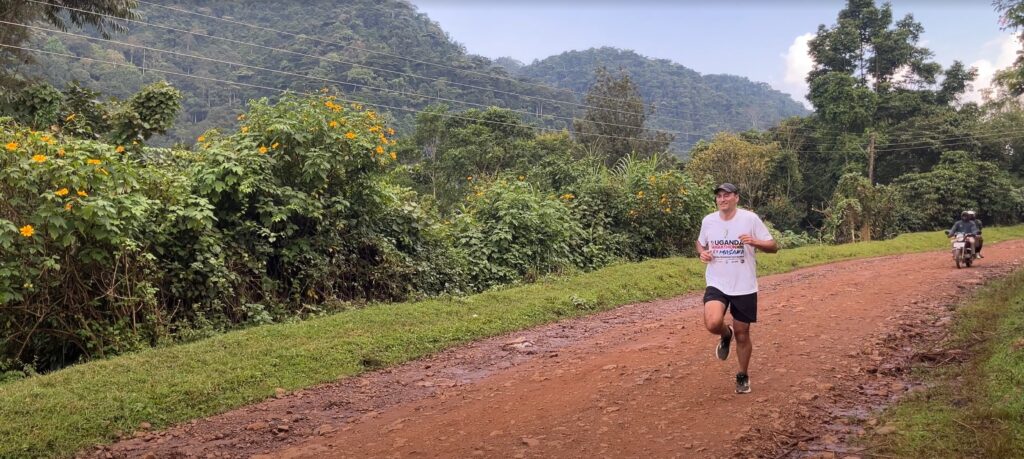
The forest pulsed with life—exotic birds called overhead, and the thought that mountain gorillas were watching from the shadows gave every step a quiet thrill.
The terrain was tough, but the energy of the forest carried us forward. It wasn’t just a run; it was a deep, emotional connection to nature and to a place of extraordinary beauty and importance.
Run logistics
Shortly after we arrived at what would be our lodge, Buhoma Gorilla Camp, I proposed to go for a run.
Btw, the lodge, defined in the internet as a "Homely Paradise", is truly fantastic. 👍 They took great care of us (that said, we were the only guests so we were very lucky!), their cuisine is amazing and they even baked a cake for us, without extra charge. Loved the place, I really recommend it.
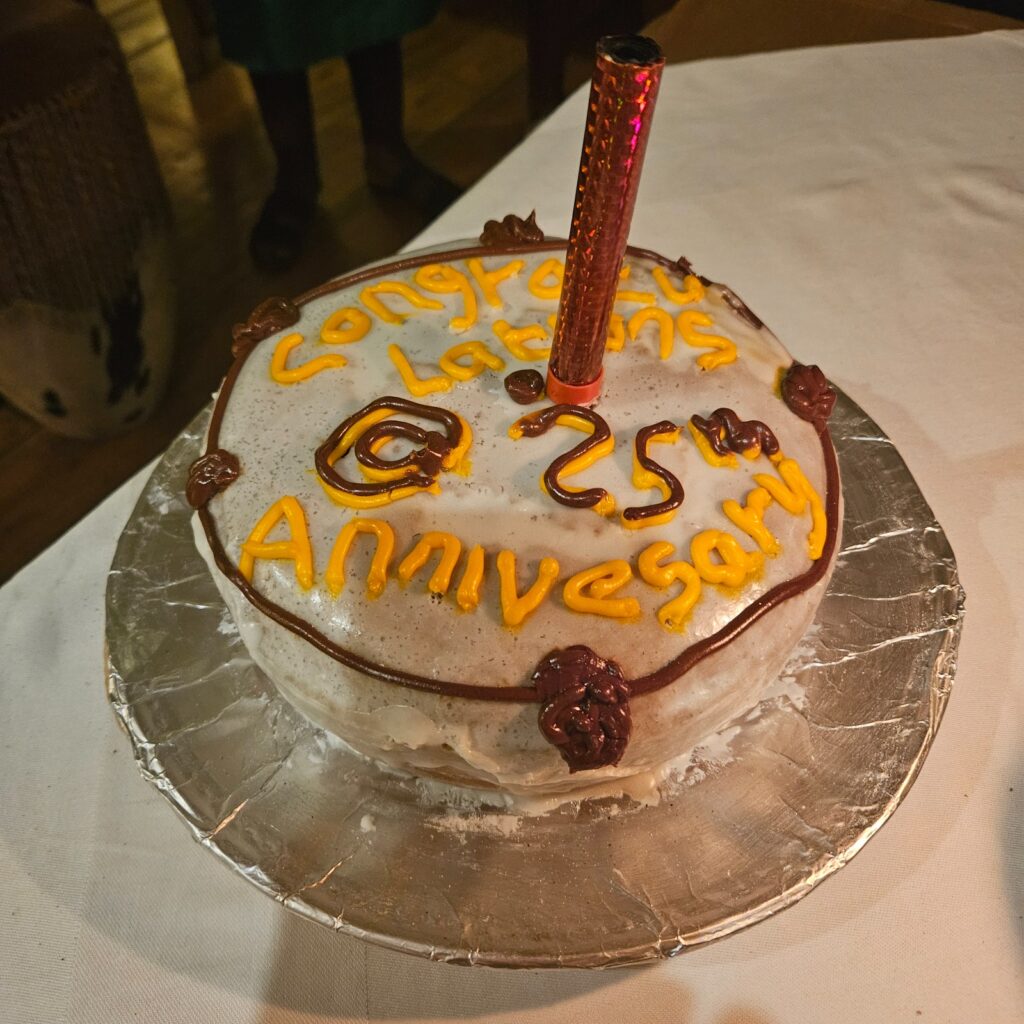
Coming by jeep, I had seen the landscape: the mountains covered in green and the winding red dirt roads through lush vegetation. I had thought the run would be quite an experience.
In fact, the terrain looked much more suited to us runners than to the vehicles, like the public buses!
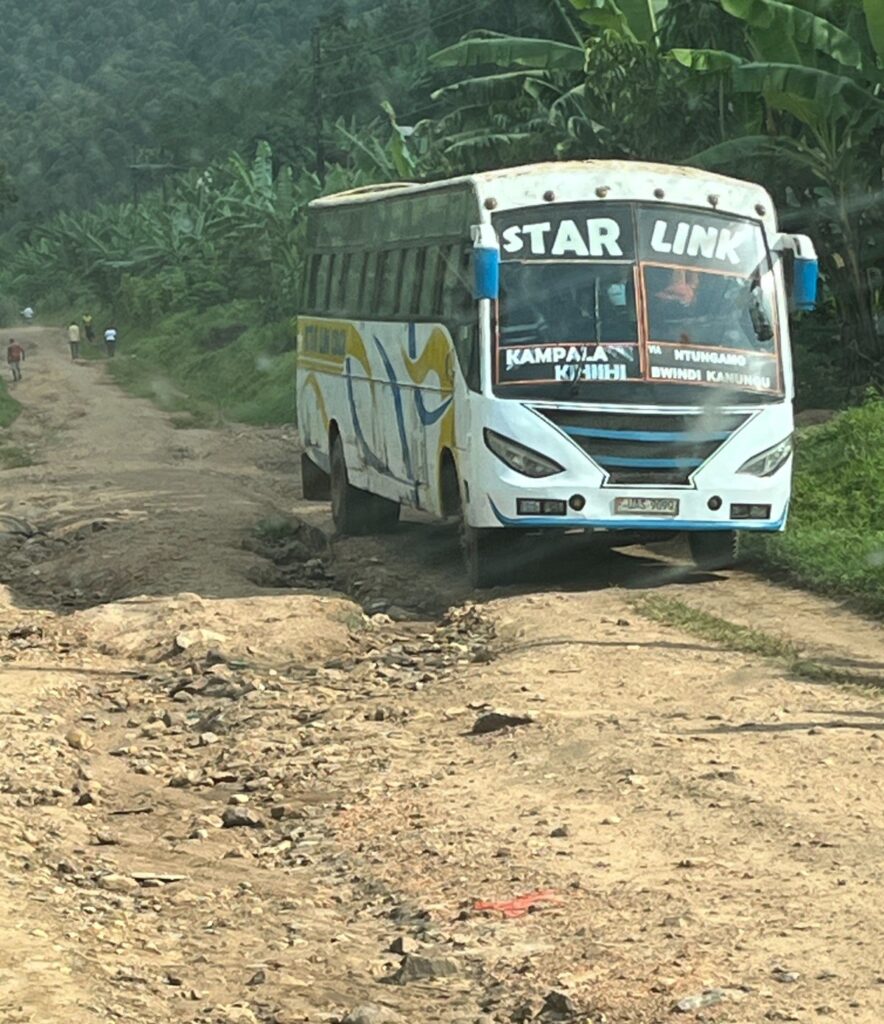
I asked the lodge manager if it was safe, and he replied with a resounding “yes, very safe.” So I argued with Roger and finally convinced him.
Roger wasn’t sure about it because he said the hills would be too steep. He looked it up on Google Maps and saw that it was 2 kilometers to the entrance of the Bwindi Impenetrable Forest, with a positive gradient of about 100 meters. We looked at what we normally do on the climb to Mount Carmel, and it turned out to be similar, so Roger agreed to go for a run.
So finally we were set to stretch our legs and go for a short run in the surrounding area!

The run was 4.2 km and was fantastic. What an experience!
The temperature was perfect. Cool.
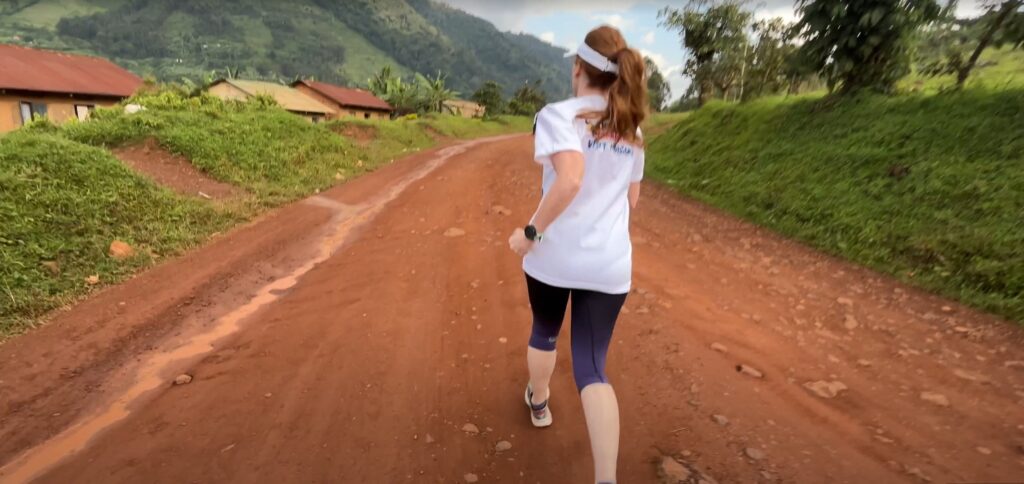
The experience
I loved the smell of wet earth and the view… of mountains and a forest… well, impenetrable.
We climbed. It was quite difficult because I wasn’t trained, but it wasn’t difficult, and the atmosphere, full of local people minding their own business, made it worthwhile.
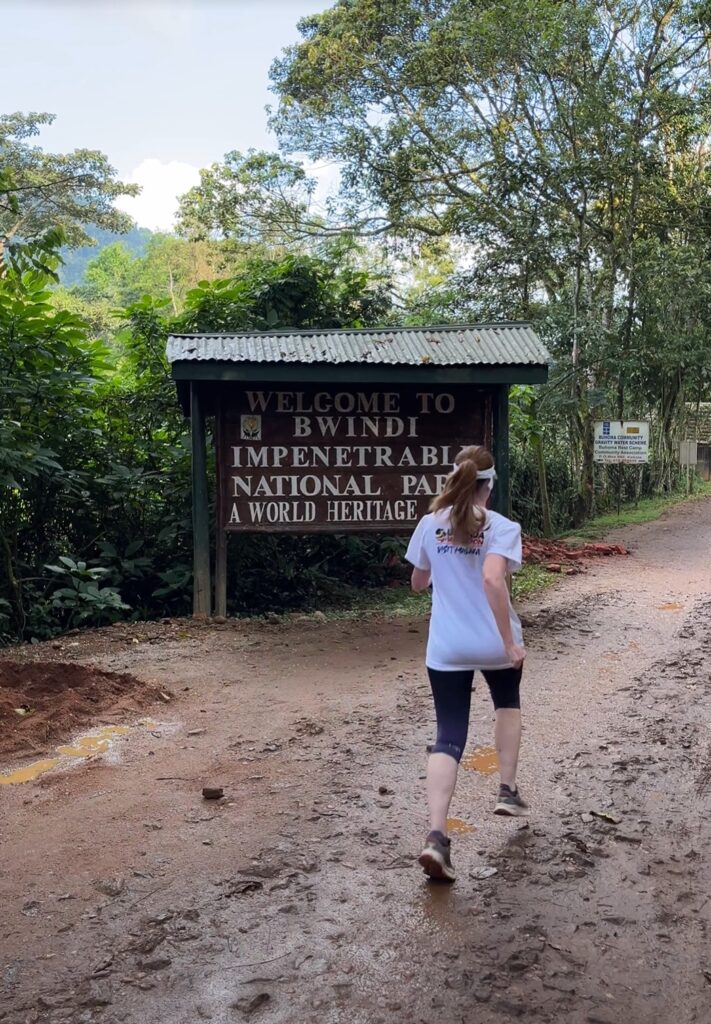
The children greeted us with “Hello, hello!” and we greeted them back. I particularly remember a very small boy in a red t-shirt who went the extra mile to greet us with impressive enthusiasm: “Helllooooo!” How cute! 🥰
We also passed some kind of crafts school where we could hear children singing, and we made a video to try to capture the atmosphere, but it was impossible.
The best thing was to stop filming and just run, listen, breathe, look around.
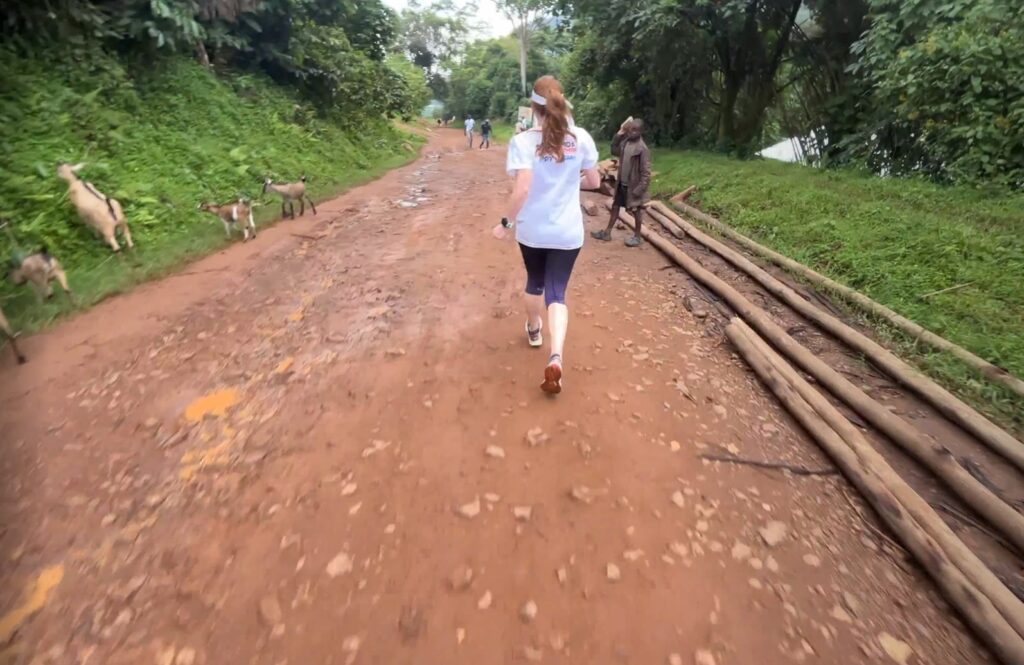
Some men were working on a construction site with extremely loud local music playing, and the African vibe was intense.
We finished the run dodging local motorcycles and the ruts in the dirt road, happy to have run in such a special place.
🍜 Carboloading 🍝: What to eat in Uganda if you are running the Uganda Marathon or just running
An unexpected introduction to Uganda’s food scene: a fancy restaurant full of fancy people
On our first day, our guide Leticia took us for lunch in the Victoria Mall, in the “Middle East Restaurant” which offered pretty much all kinds of food! Salads and Hummus and Shawarma and Burgers and Shakes and Cakes and Ice creams!
I took my fascination with the sweet stuff a little bit too far, though. I ordered a “Snickers shake” and then had to rest my stomach for a few hours…
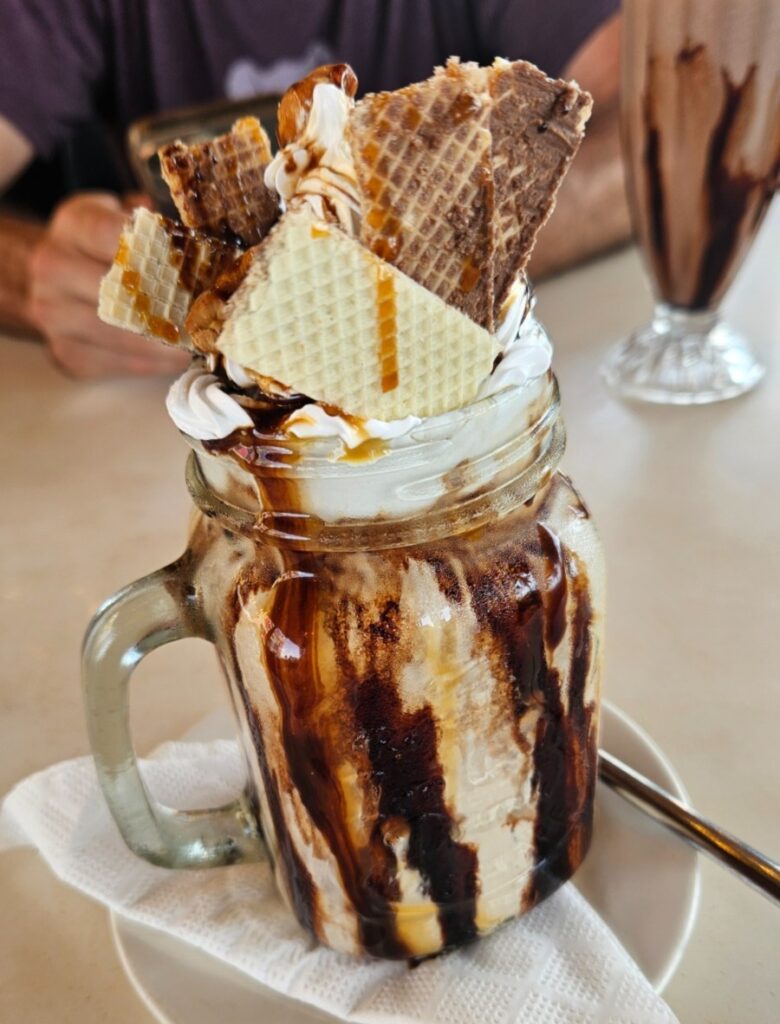
And for the first time in my life I saw Roger NOT finishing his dish. Here’s a very strange picture of Roger being defeated by a big portion:
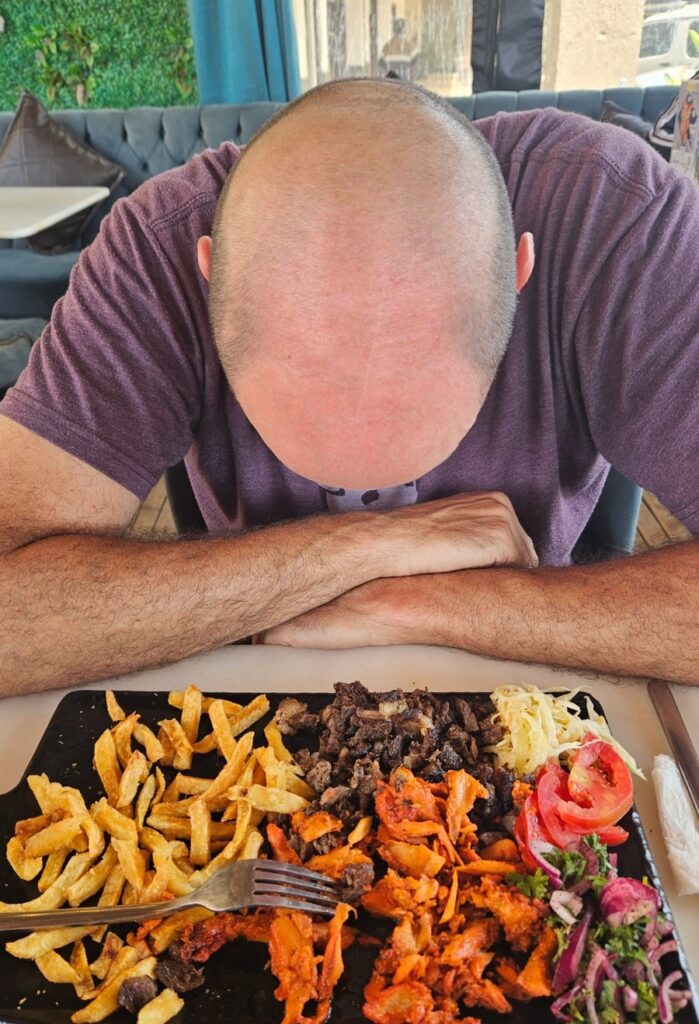
The restaurant was full of very fashionable people. I loved the infinite braids of both the waitresses and most of the guests. Later, I found out there were mostly extensions 🙂
Also the staff was very attentive and it all had the air of an American restaurant. And I say this because the dishes were massive! We didn’t feel like we were in Africa (other than the staff looking very local with their braids)..
Anyway, it’s a very good option if you are in Entebbe, which you probably will be if you visit Uganda, as the airport is here.
In the following days, though, we had a true immersion in Ugandan cuisine!
“Delicious Rolex” 🥙
They were everywhere! Our guide first explained about them when we arrived.
Because, in Uganda, a rolex is not a luxury watch — it’s a delicious and iconic street food! The name comes from the phrase “rolled eggs”. It consists of:
- Chapati (a soft, round flatbread)
- Egg omelette mixed with vegetables like onions, tomatoes, and cabbage
The omelette is placed on the chapati and rolled up — hence the name “rolex”!
It is very popular because it is very affordable (often around 2,000–3,000 Ugandan Shillings).
Spanish Omelette
We discovered that in Uganda, “Spanish Omelette” is not what we in Spain understand as such, our “tortilla de patatas” (Omelette with potatoes).
Here it is a French Omelette, but very small slices of green and red peppers, onions and tomatoes:
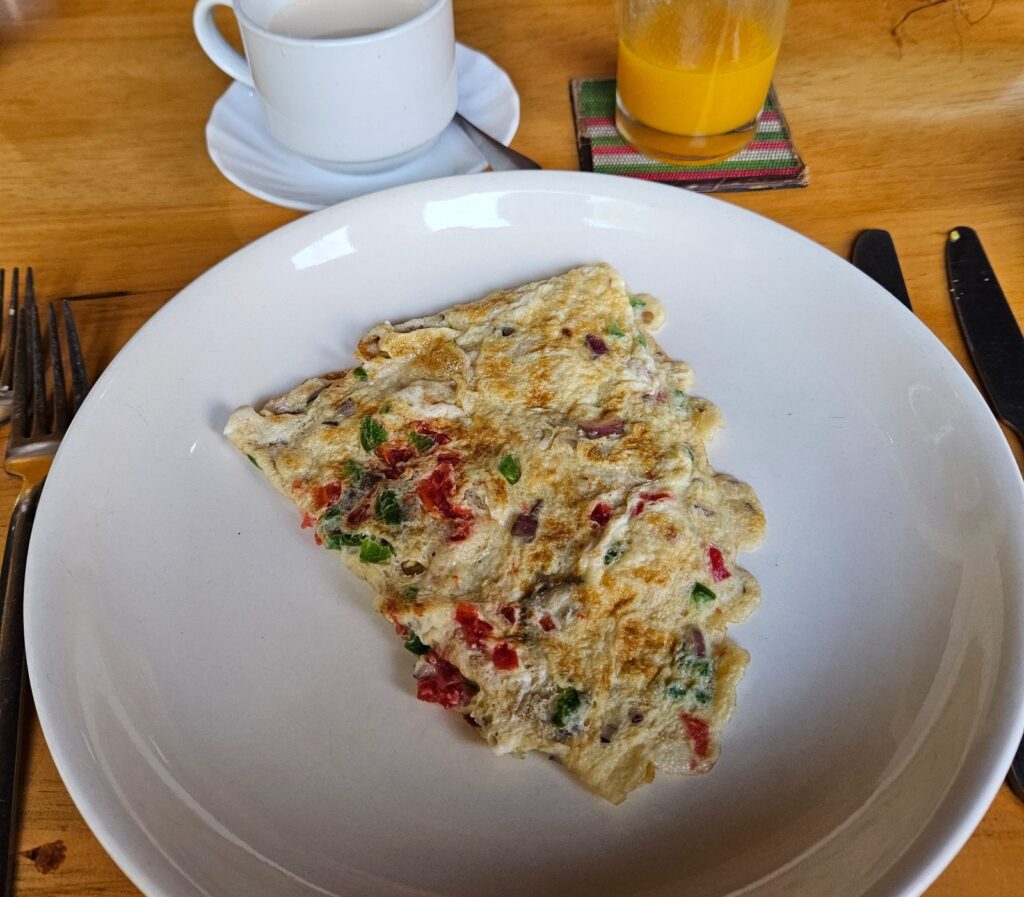
Funny thing: I asked chatgpt about it and it got it wrong 😣
African Tea 🍵
Another ‘discovery’ we made here was “African Tea”, which seemed to be a version of the “somali tea” which I had tasted in Djibouti and which I also enjoyed in the Volcanos National Park in Rwanda.
In Uganda, African tea refers to a spiced milk tea that’s rich, creamy, and deeply comforting. It’s made by boiling black tea leaves directly in a mixture of milk and water, then adding spices like ginger, cardamom, cinnamon, or cloves, depending on the household or region.
Sugar is usually added generously, and the tea is strained before serving. Unlike regular tea where milk is added after brewing, African tea is cooked with the milk, giving it a thicker, more flavorful profile. It’s commonly enjoyed at breakfast or in the evening and is a warm symbol of Ugandan hospitality and daily life.
Carboloading: start with Matoke or Sweet Potatoes
Before a run in Uganda, you’ll want to fuel up on carbohydrate-rich foods to provide your body with the energy it needs for sustained performance. Ugandan cuisine offers an array of delicious, natural options that are perfect for loading up on slow-releasing and fast-releasing carbs.
One of the best pre-run meals is matoke, Uganda’s staple dish made from steamed green bananas. Matoke provides a steady source of complex carbohydrates, giving you long-lasting energy without causing a sugar spike. For added nutrition, you can pair matoke with a light vegetable stew or a touch of peanut sauce for flavor and some healthy fats. Similarly, sweet potatoes (especially the orange-fleshed variety) are another excellent option. They are rich in complex carbs, vitamin C, and potassium, helping to prevent muscle cramps while providing sustained energy.
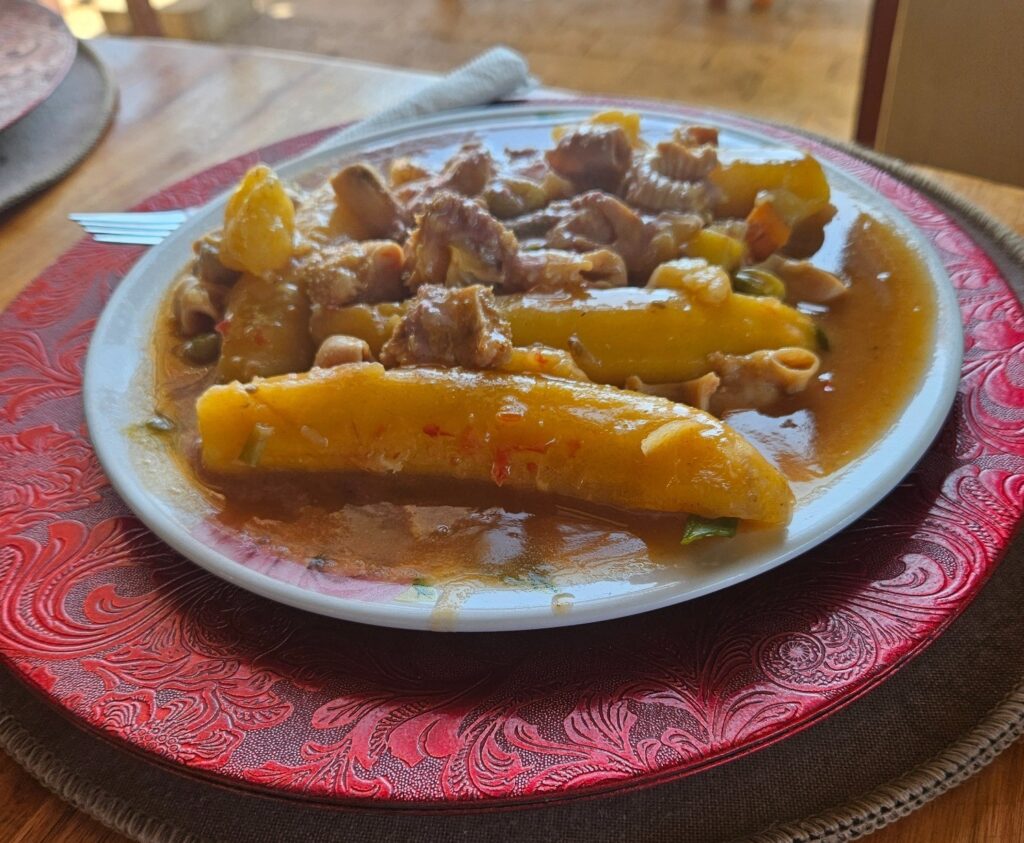
Protein Recovery
After a long run in Uganda, it’s crucial to replenish your body with protein-rich foods to aid muscle recovery and overall replenishment.
Ugandan cuisine offers a variety of nutritious options that are perfect for post-workout recovery, combining proteins with healthy carbohydrates and fats to restore energy and repair tissues.
A great post-run meal could include Luwombo, a traditional Ugandan dish. Opt for chicken or beef luwombo, which is steamed in banana leaves and accompanied by vegetables. Or just a “standard” steak, which is widely available over the country!

Map
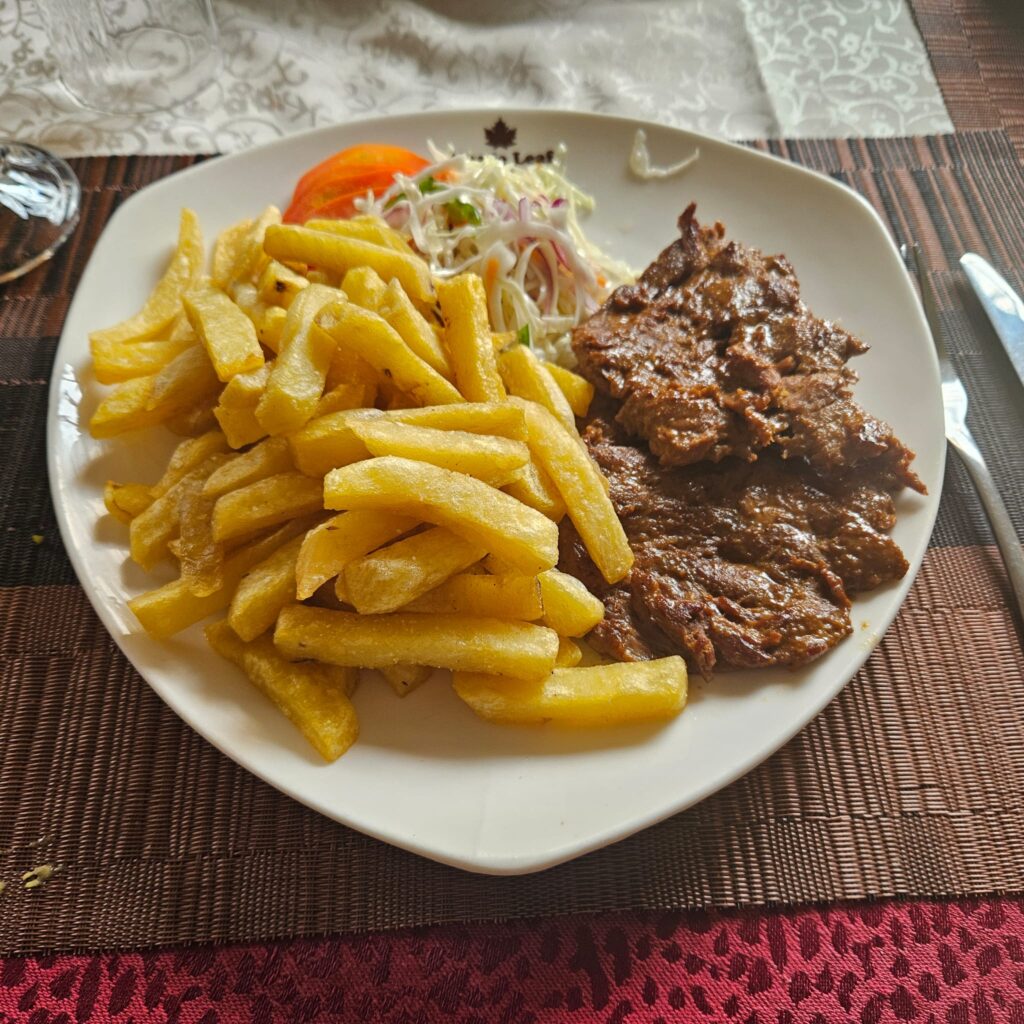

Useful information
🏆 Uganda Marathon: Marathon, Half Marathon, 10k and 5k.
🌐 Website: https://ugandamarathon.com/
🏃 Number of runners: between 300-500. A small international group of runners who mostly sign up for the 1-week long adventure, and a couple hundred locals, including many kids.
🗓️ End of May in Uganda, Africa.
👟 Bring shoes for trail running, sun protection and hydration.
✅ It is truly and adventure, including the possiblity of getting lost 😇
✅ You get to run with locals and enjoy the daily life of Masaka on a working day: the markets, the colours, the scenery… it is worth the effort!
⚠️ It is not a race for a PB: hilly and without water stations. Plus you are likely to end up running a random distance.

Map
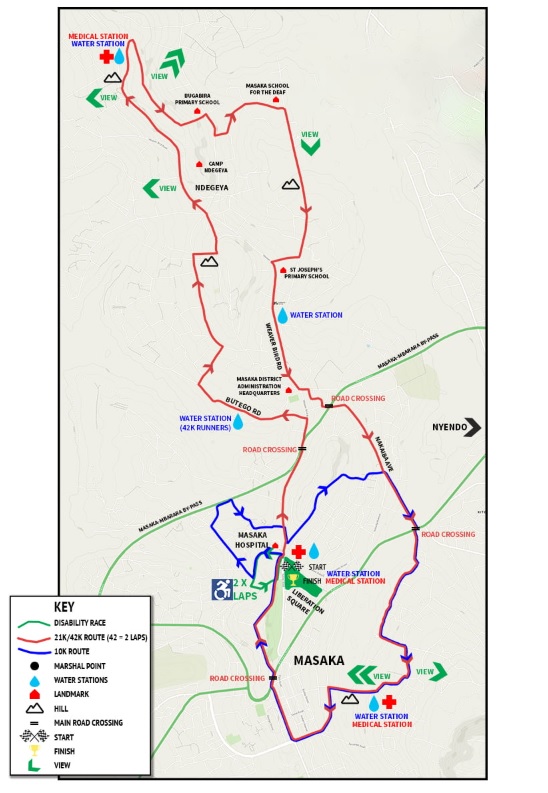

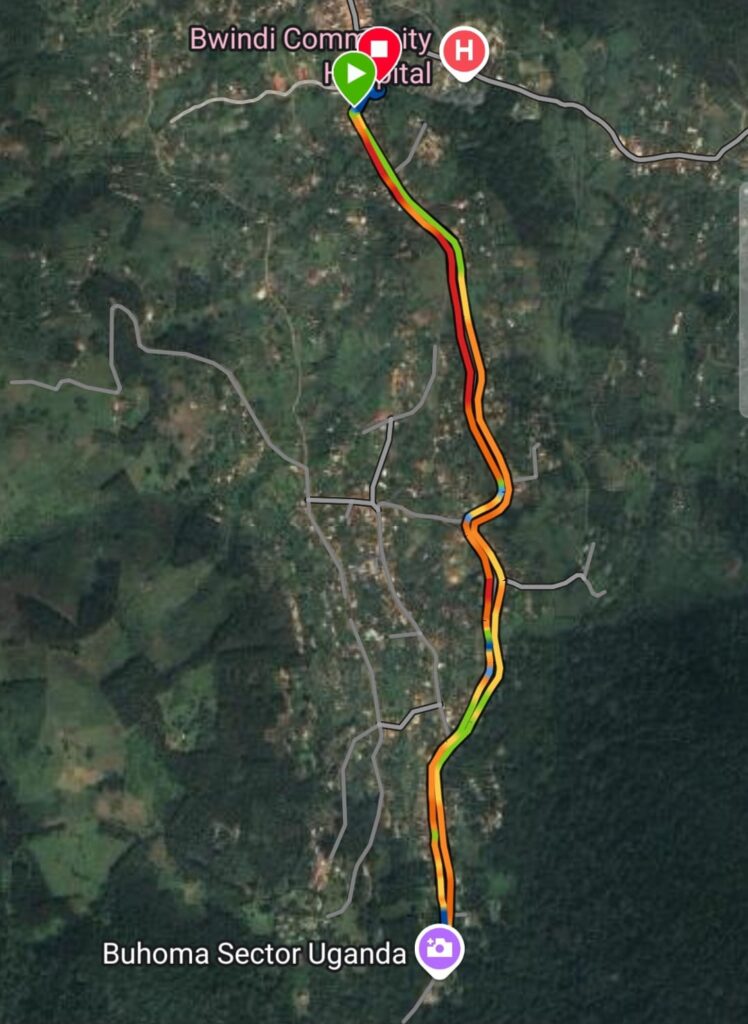
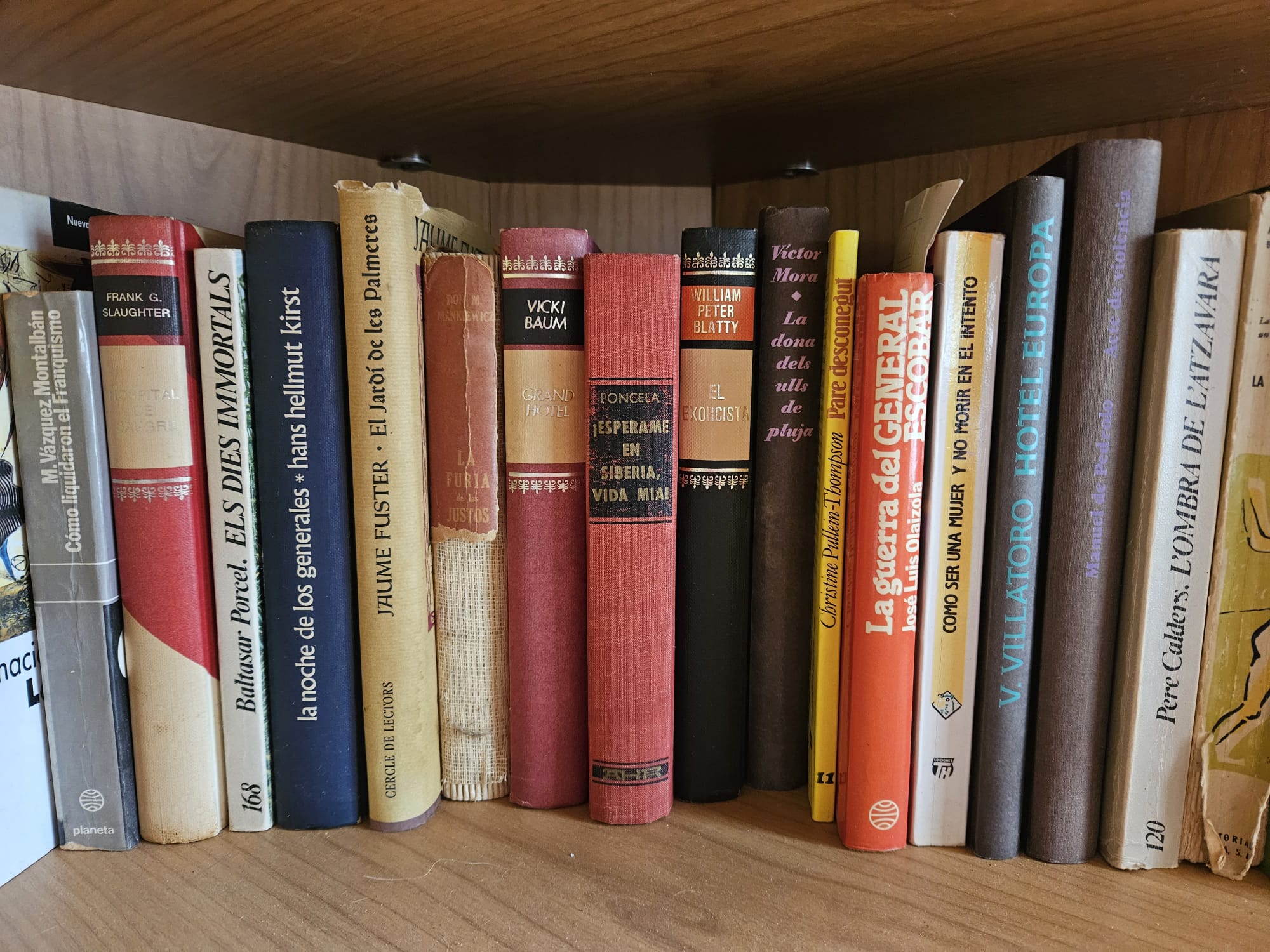
One book
Kintu, by Jennifer Nansubuga Makumbi
Kintu by Jennifer Nansubuga Makumbi is absolutely worth reading for several reasons, especially if you’re someone who loves deep, multi-layered storytelling and a strong connection to culture and history.
It spans generations, tracing the lives of a single family cursed in 1750. The novel explores how the past ripples through generations, shaping identities, destinies, and relationships. It’s a profound examination of how ancestral choices and trauma echo through time.
The novel is deeply rooted in Ugandan history, folklore, and traditions, giving readers a vivid sense of life in Uganda across centuries. Makumbi masterfully blends the mythical with the real, presenting an authentic, nuanced portrait of the country that you won’t get in a te
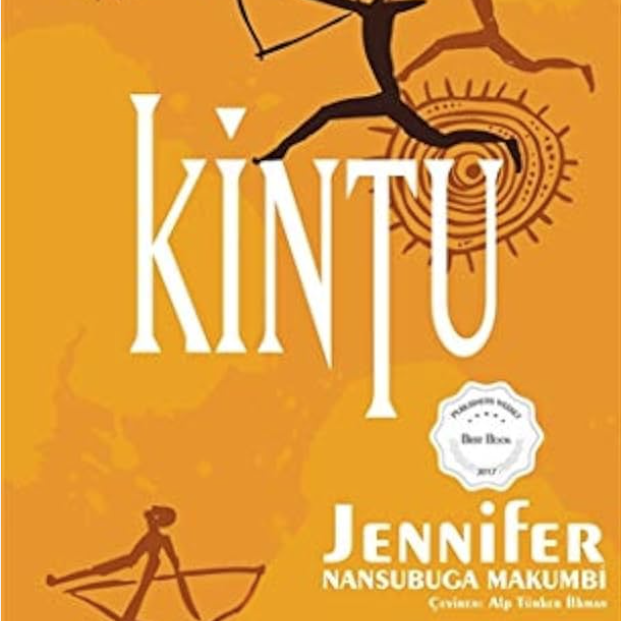
Plot Summary: First published in Kenya in 2014 to critical and popular acclaim, Kintu is a modern classic, a multilayered narrative that reimagines the history of Uganda through the cursed bloodline of the Kintu clan. Divided into six sections, the novel begins in 1750, when Kintu Kidda sets out for the capital to pledge allegiance to the new leader of the Buganda Kingdom. Along the way, he unleashes a curse that will plague his family for generations. In an ambitious tale of a clan and a nation, Makumbi weaves together the stories of Kintu’s descendants as they seek to break from the burden of their shared past and reconcile the inheritance of tradition and the modern world that is their future.
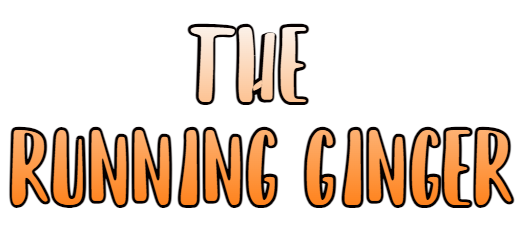
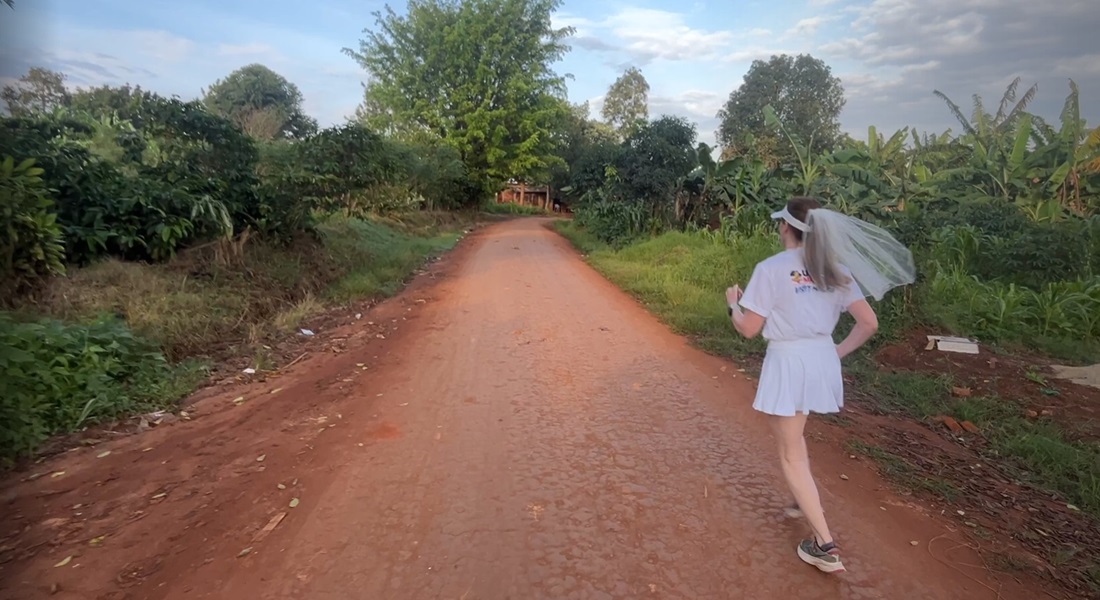
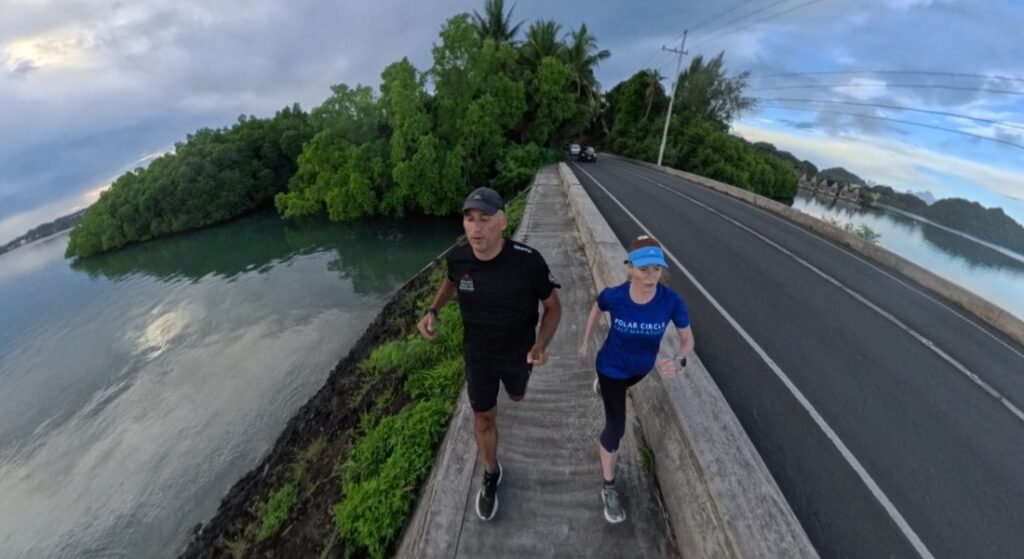

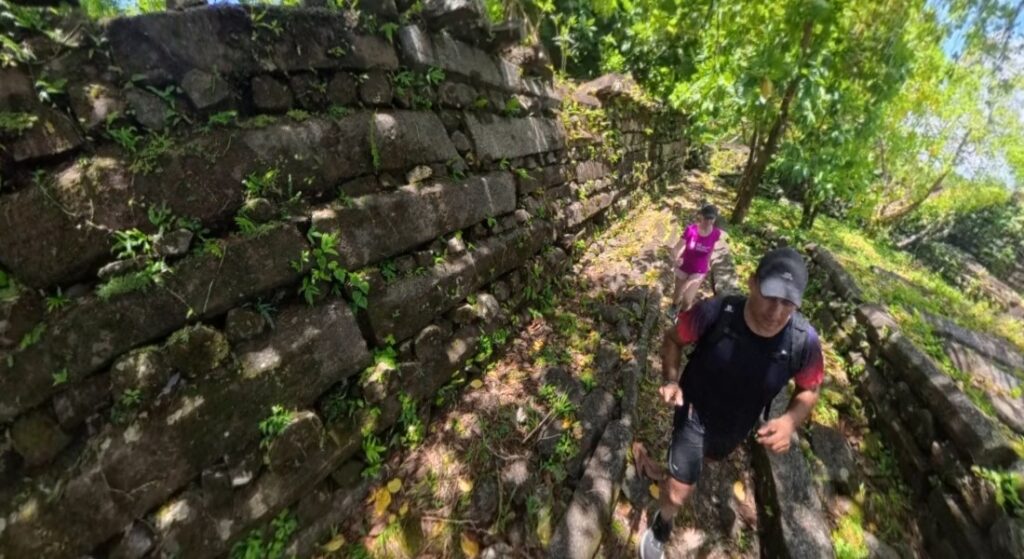
One Comment